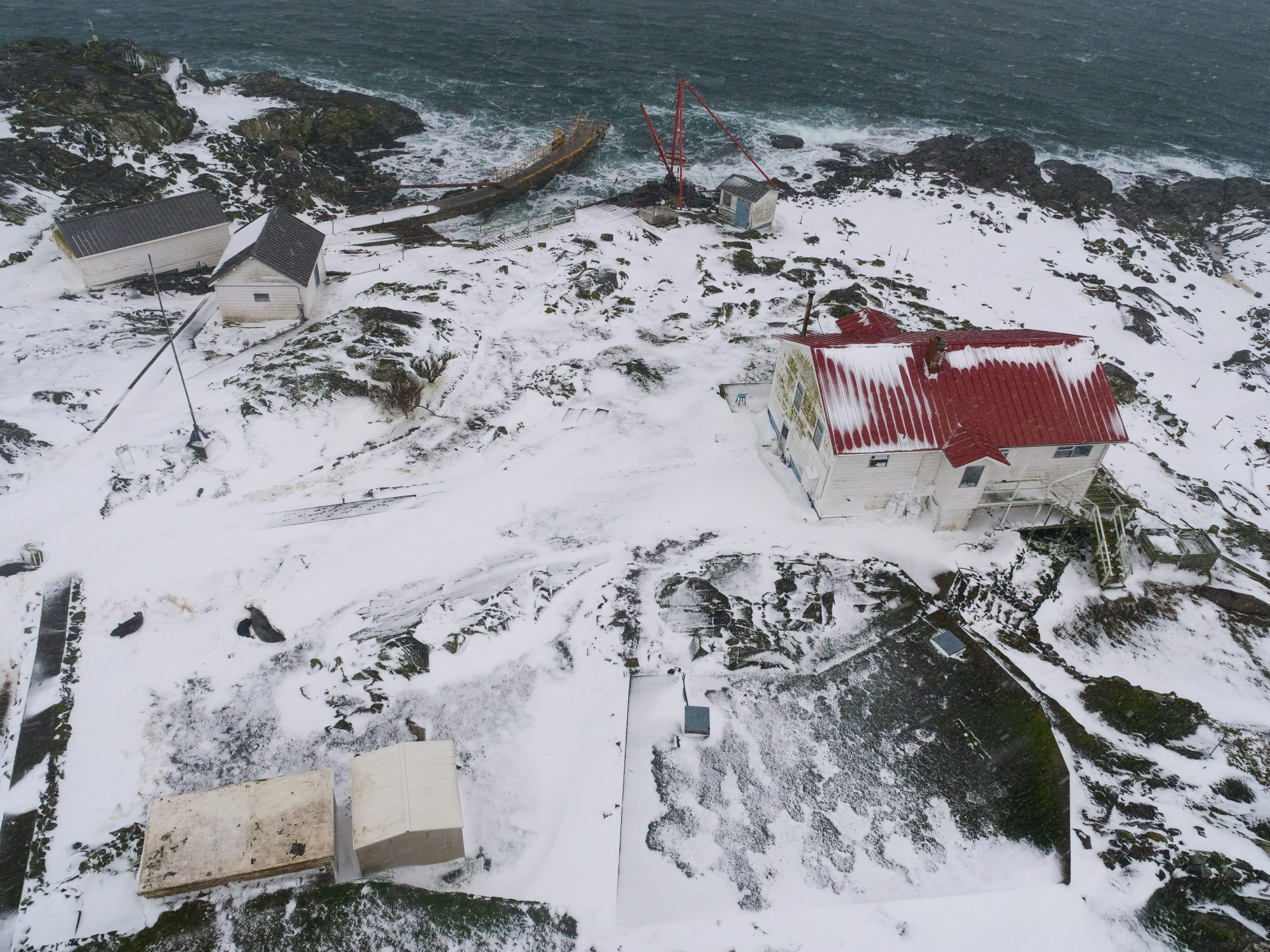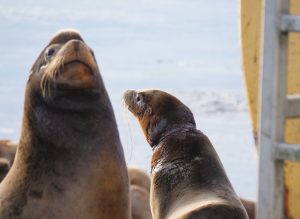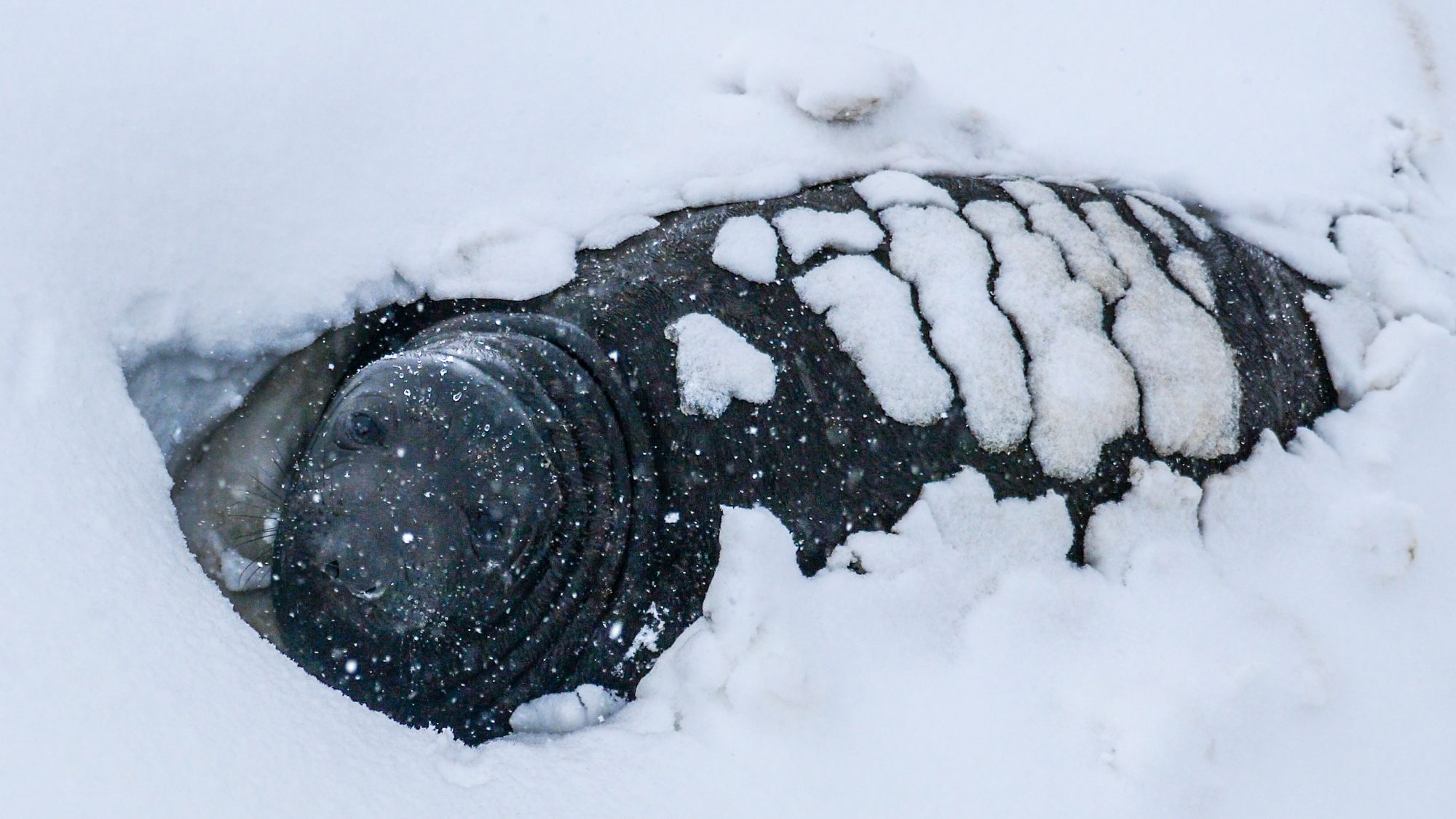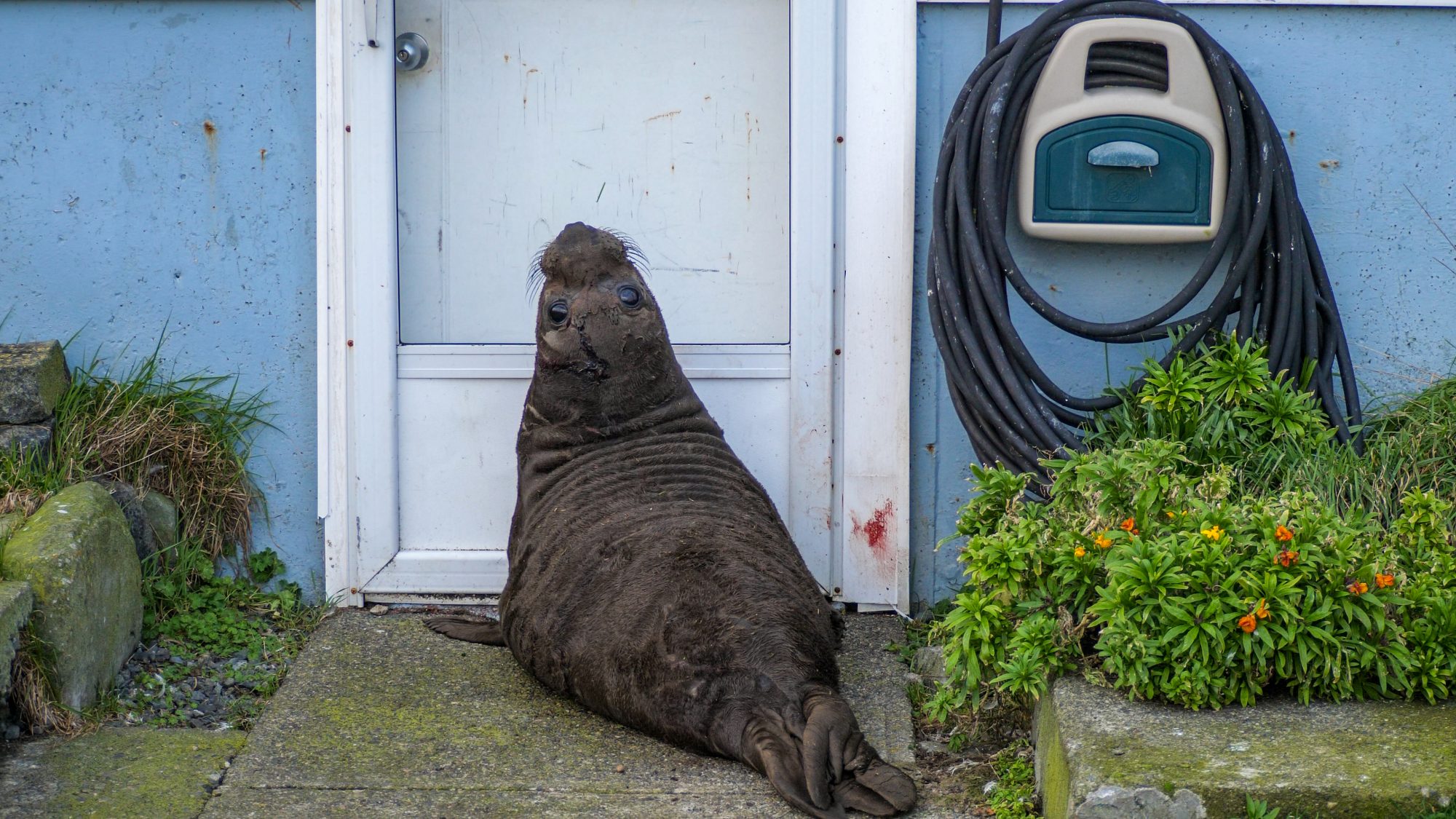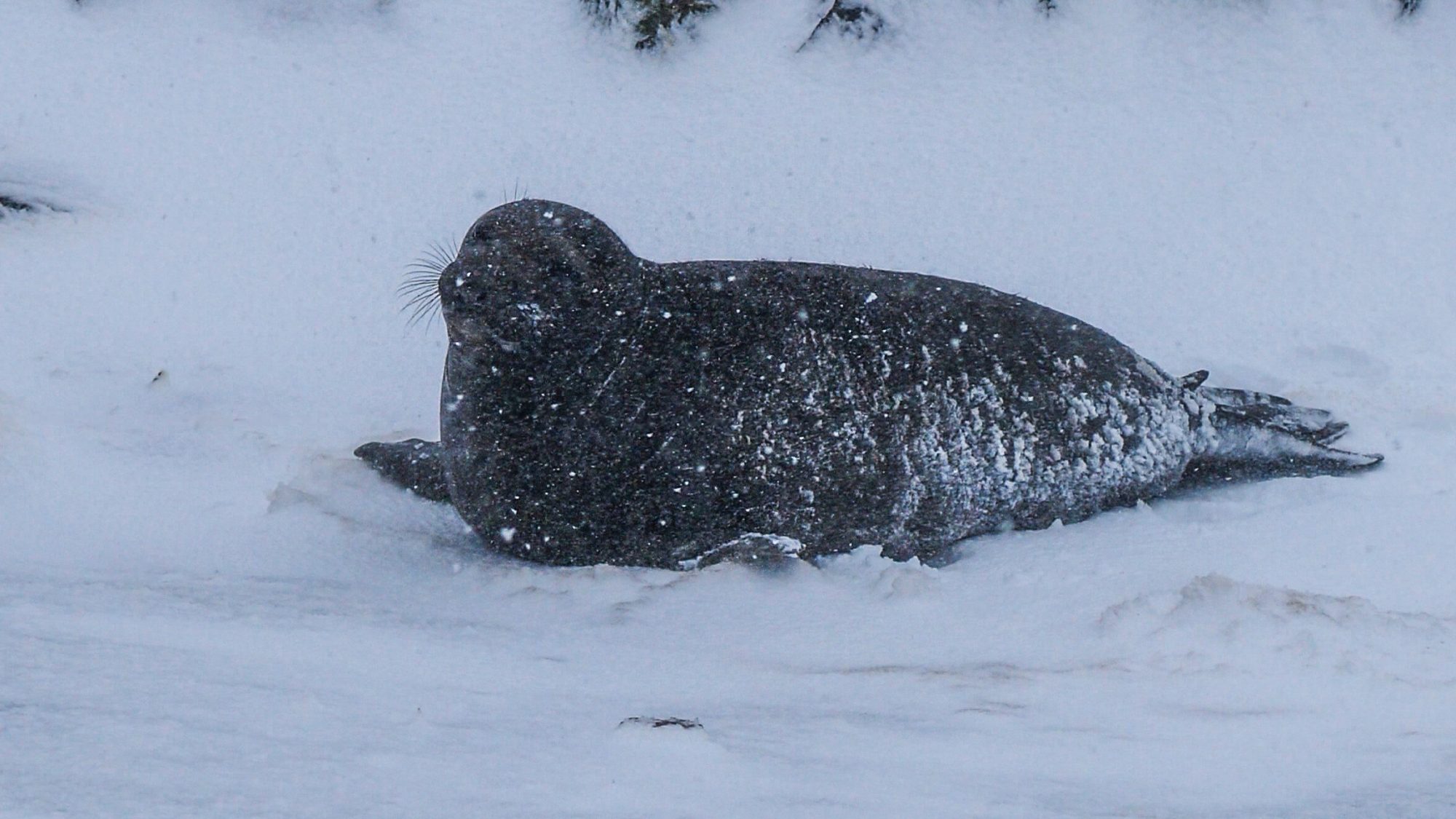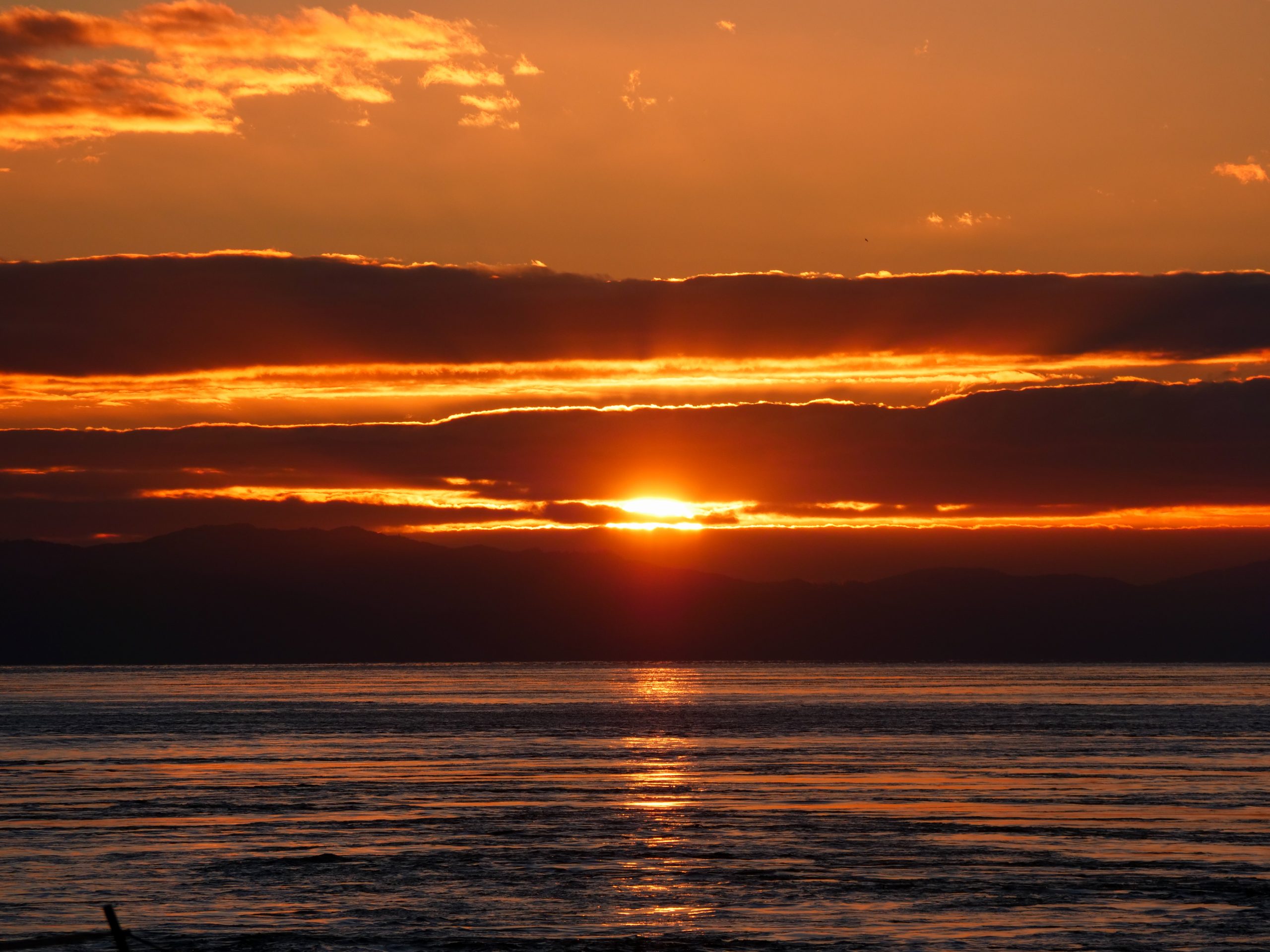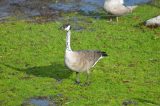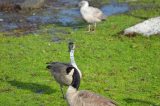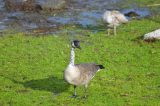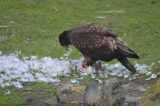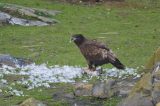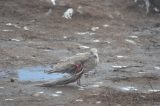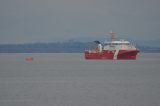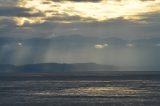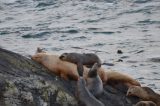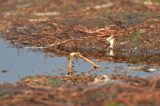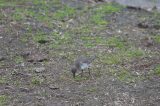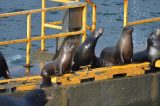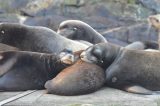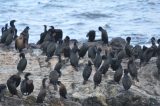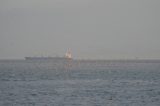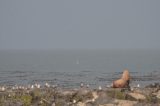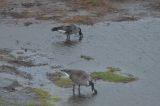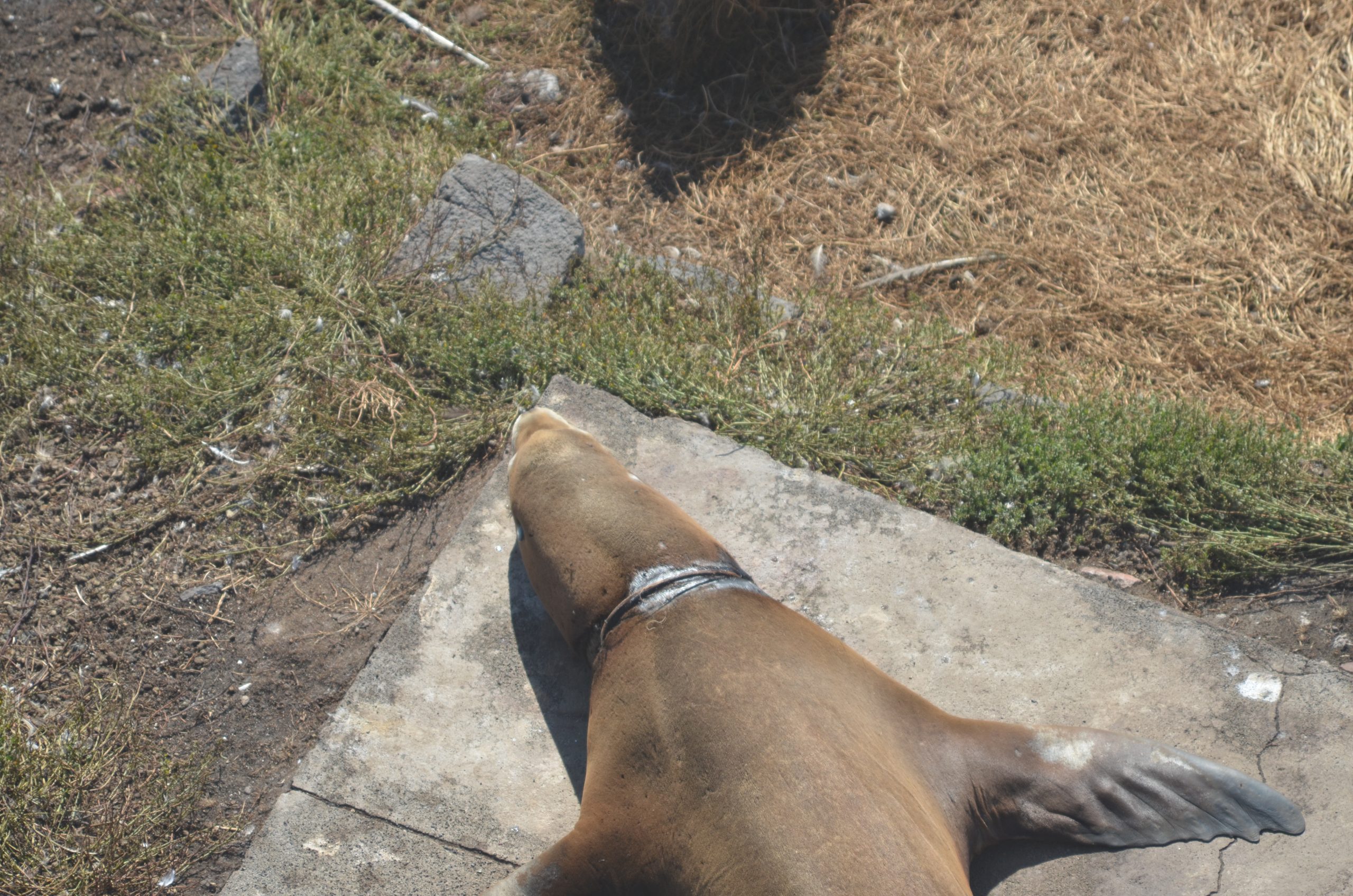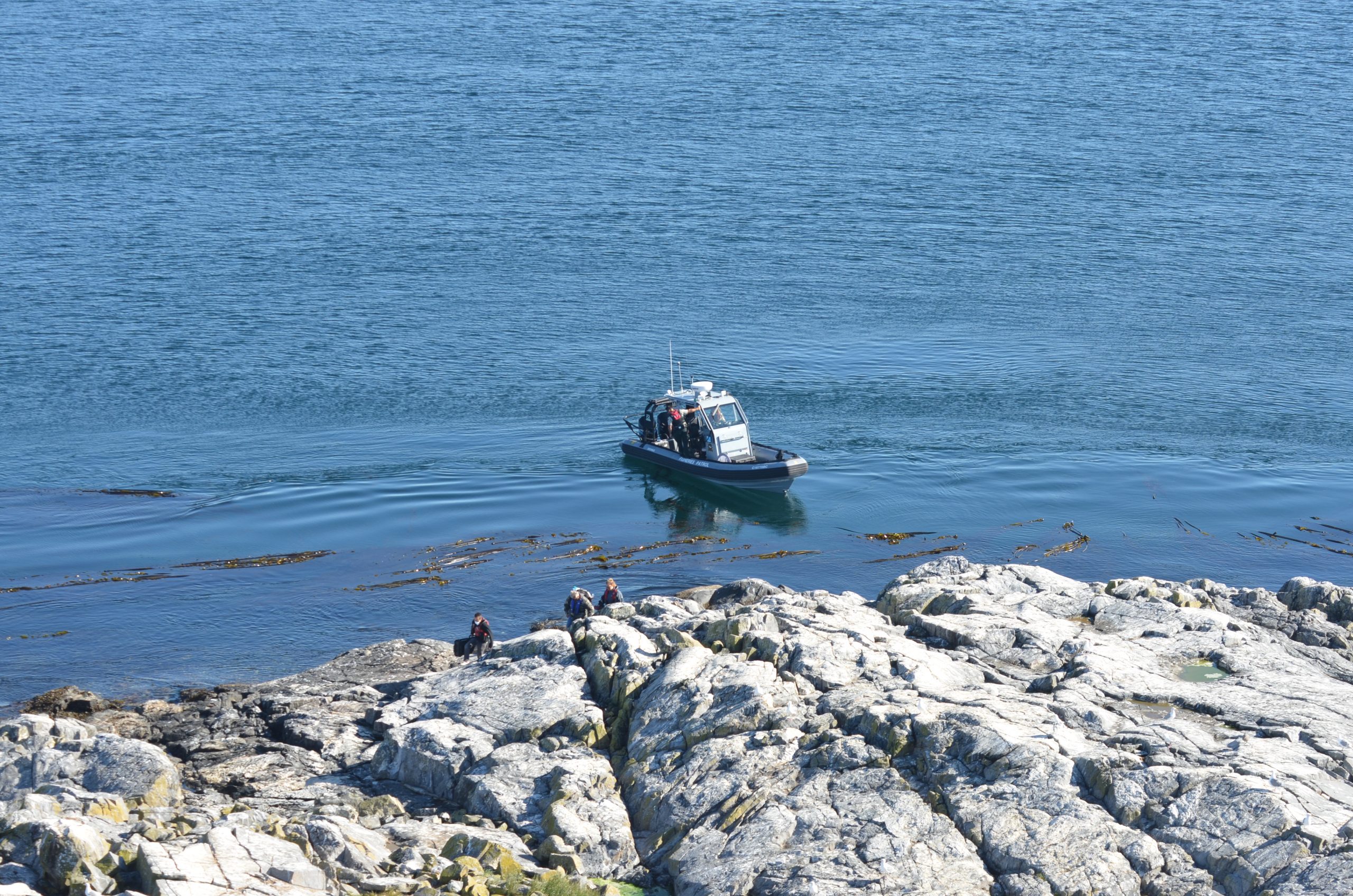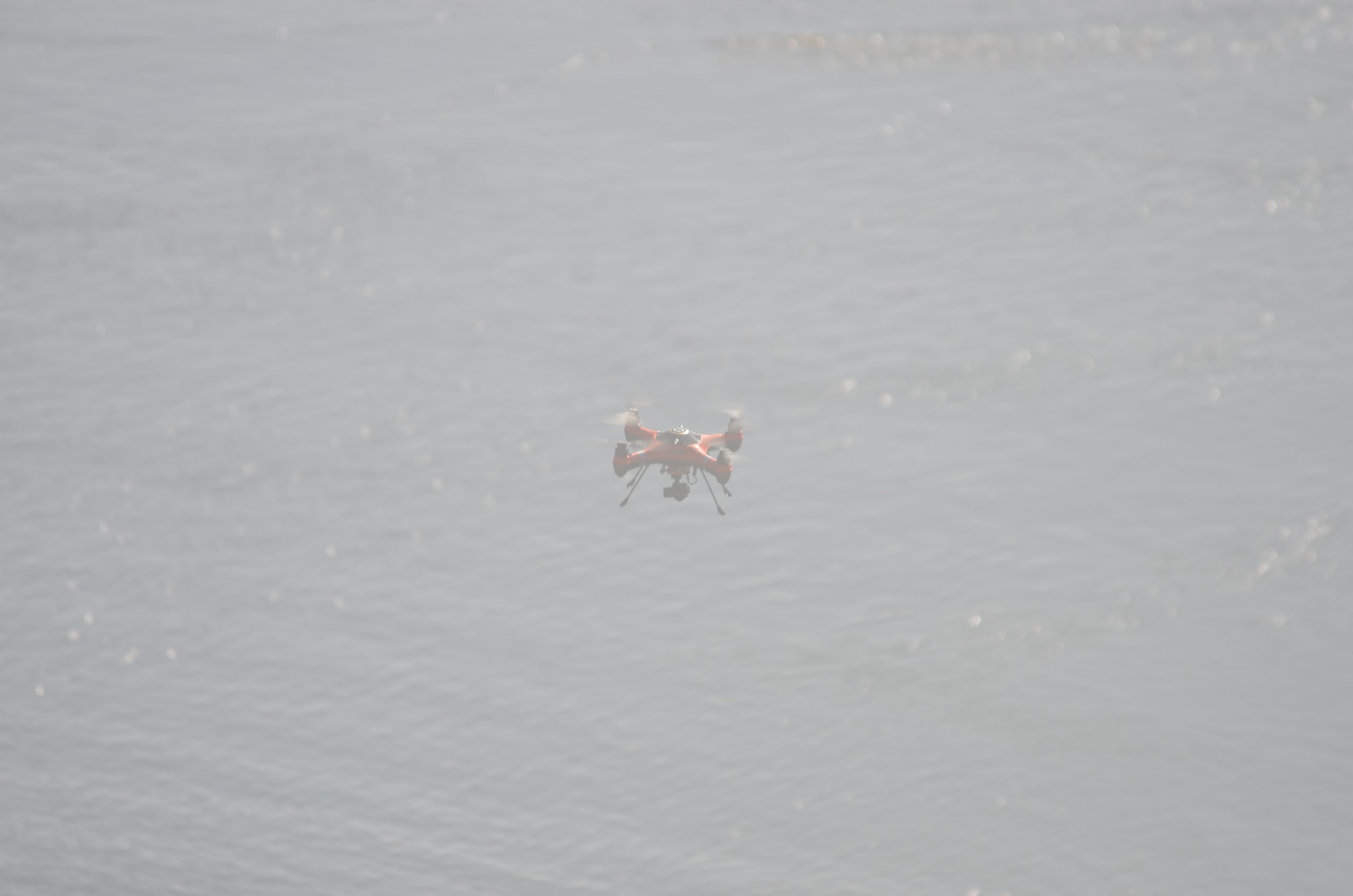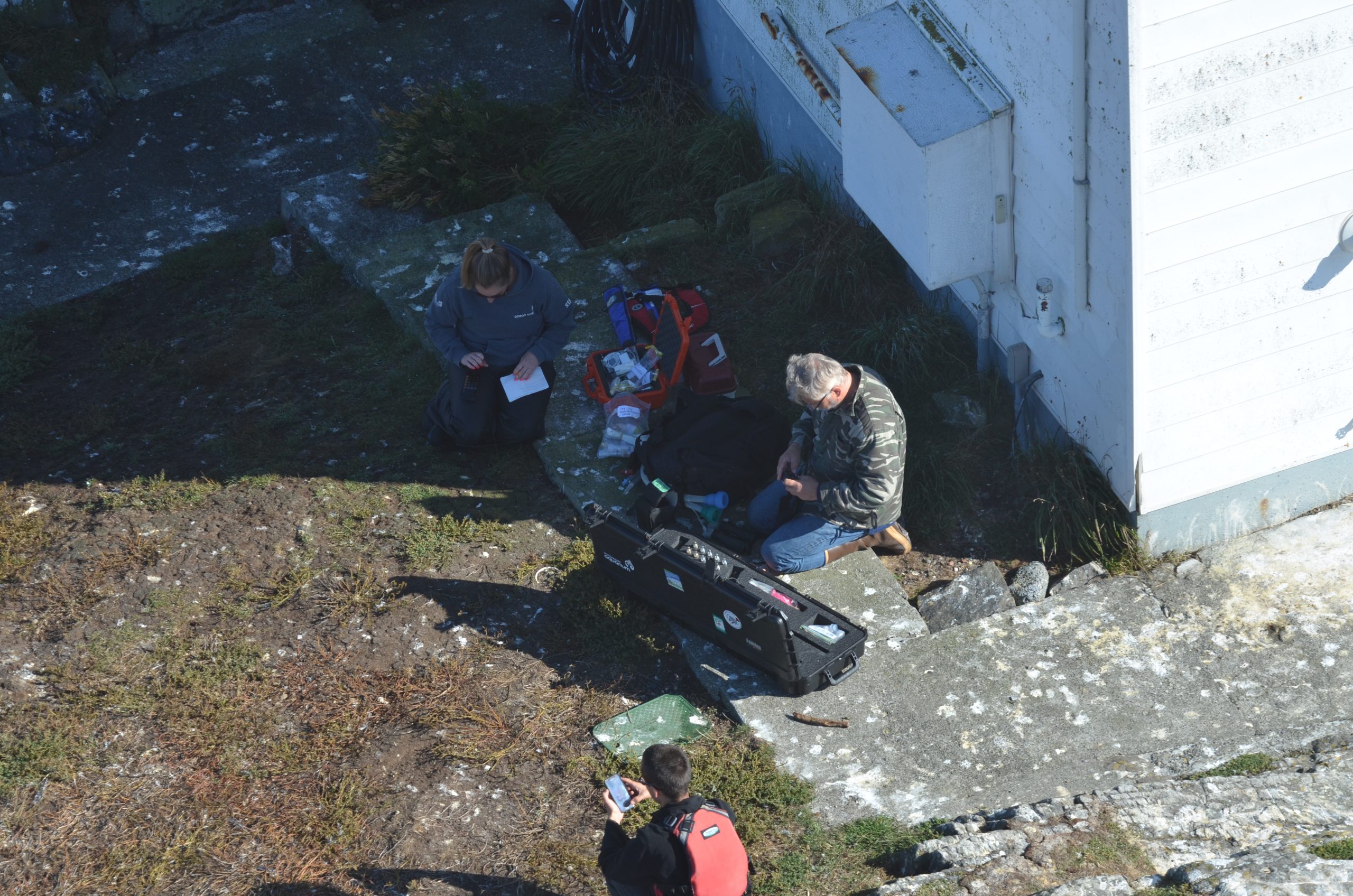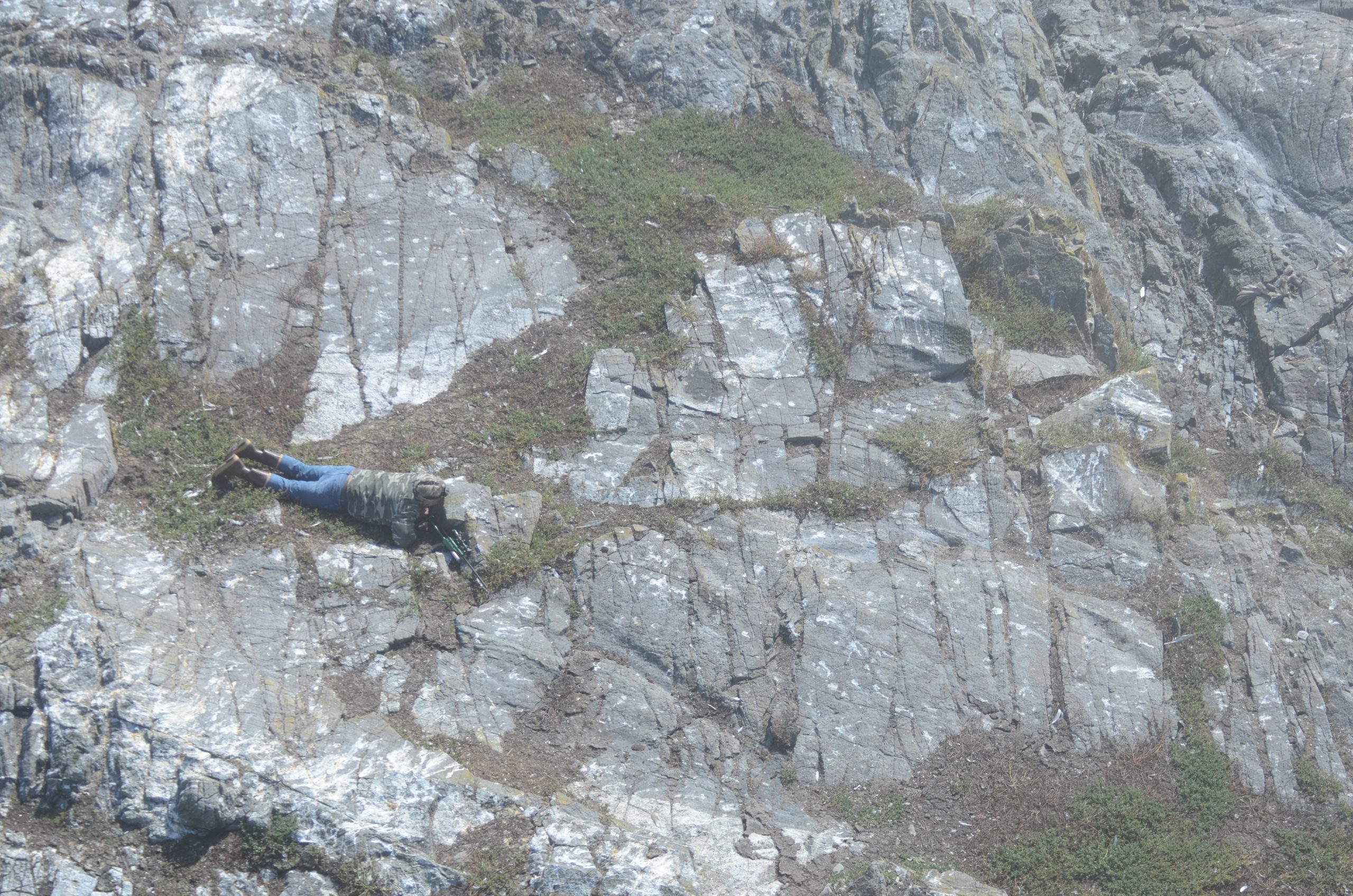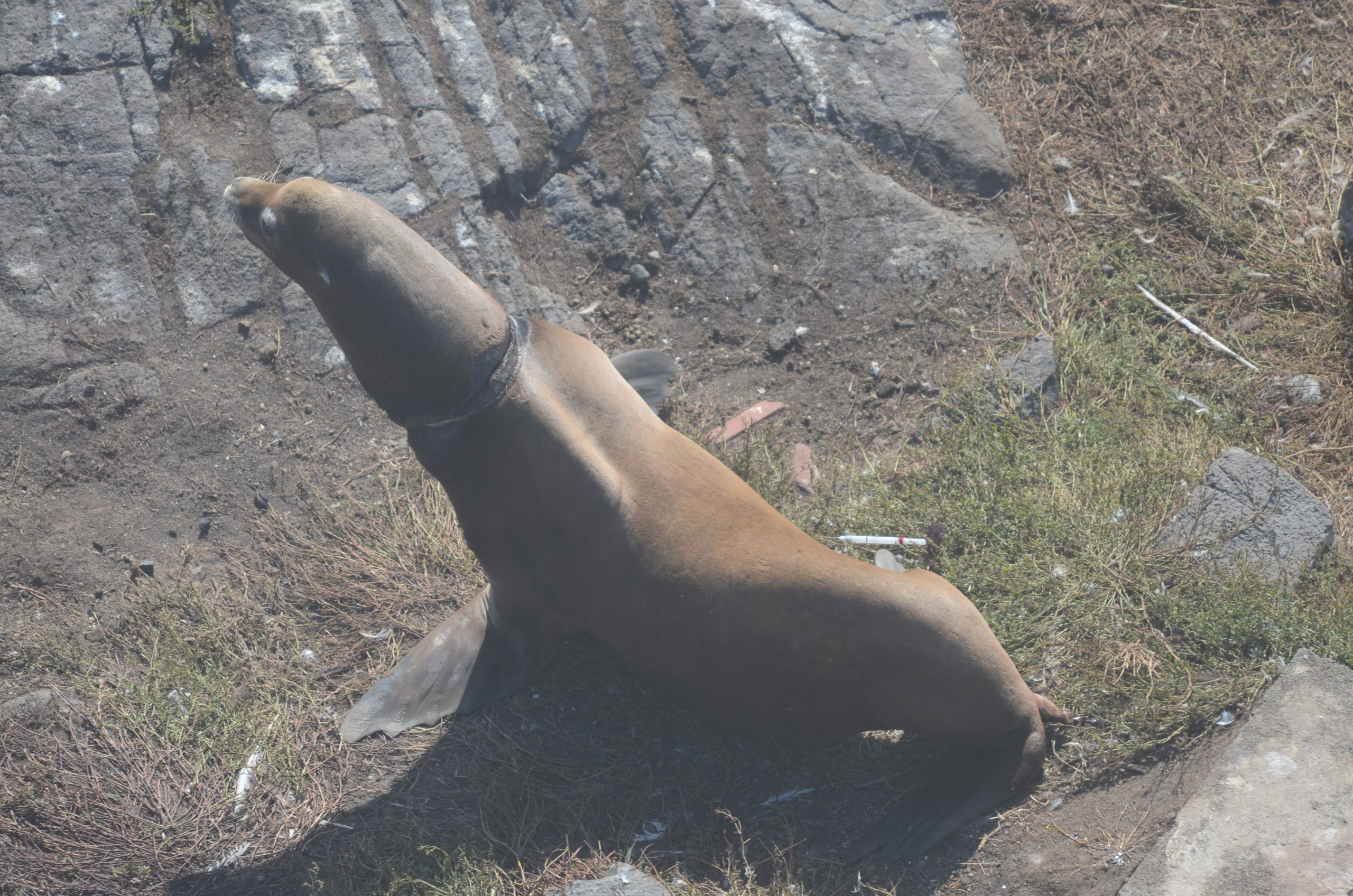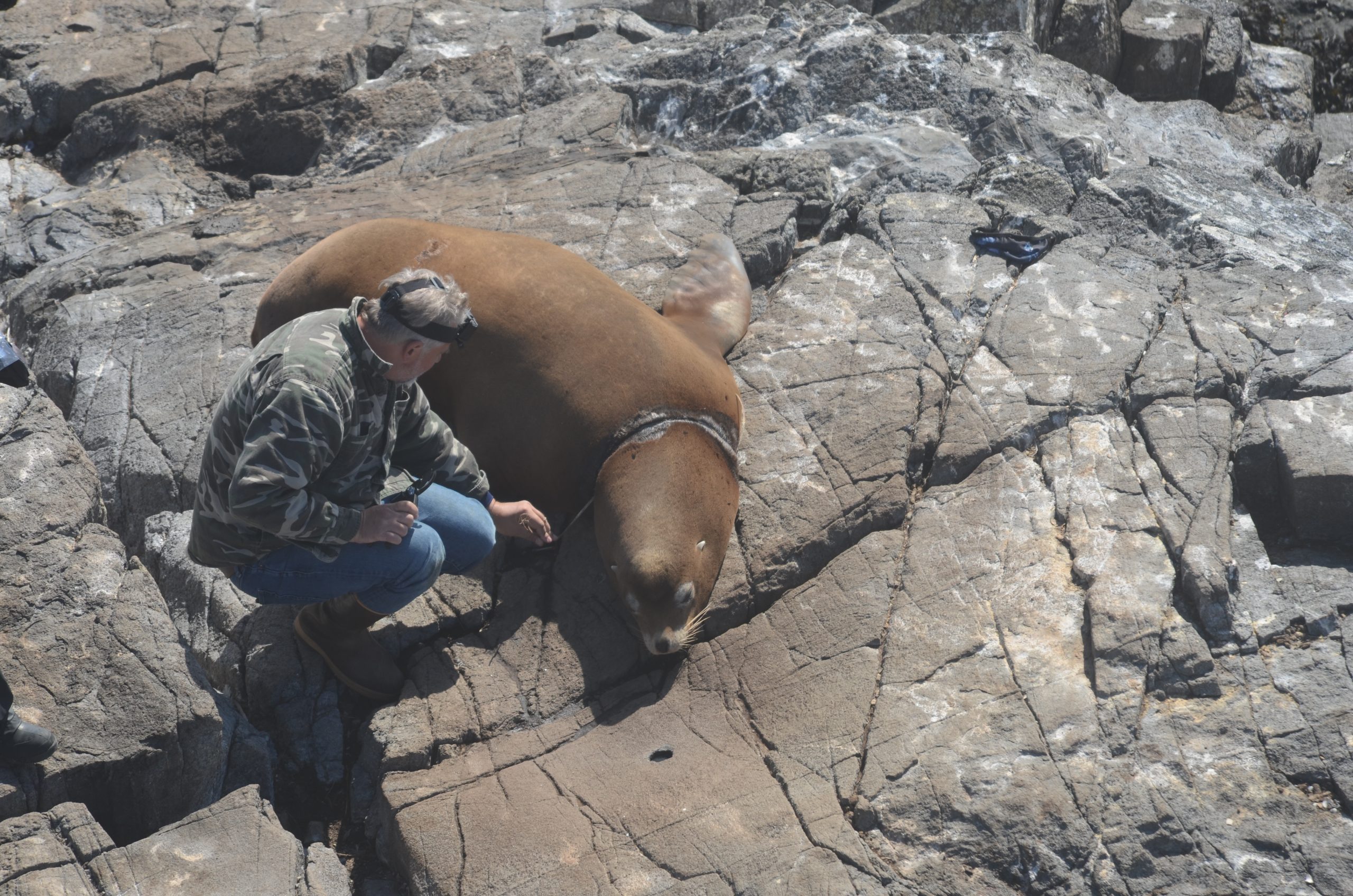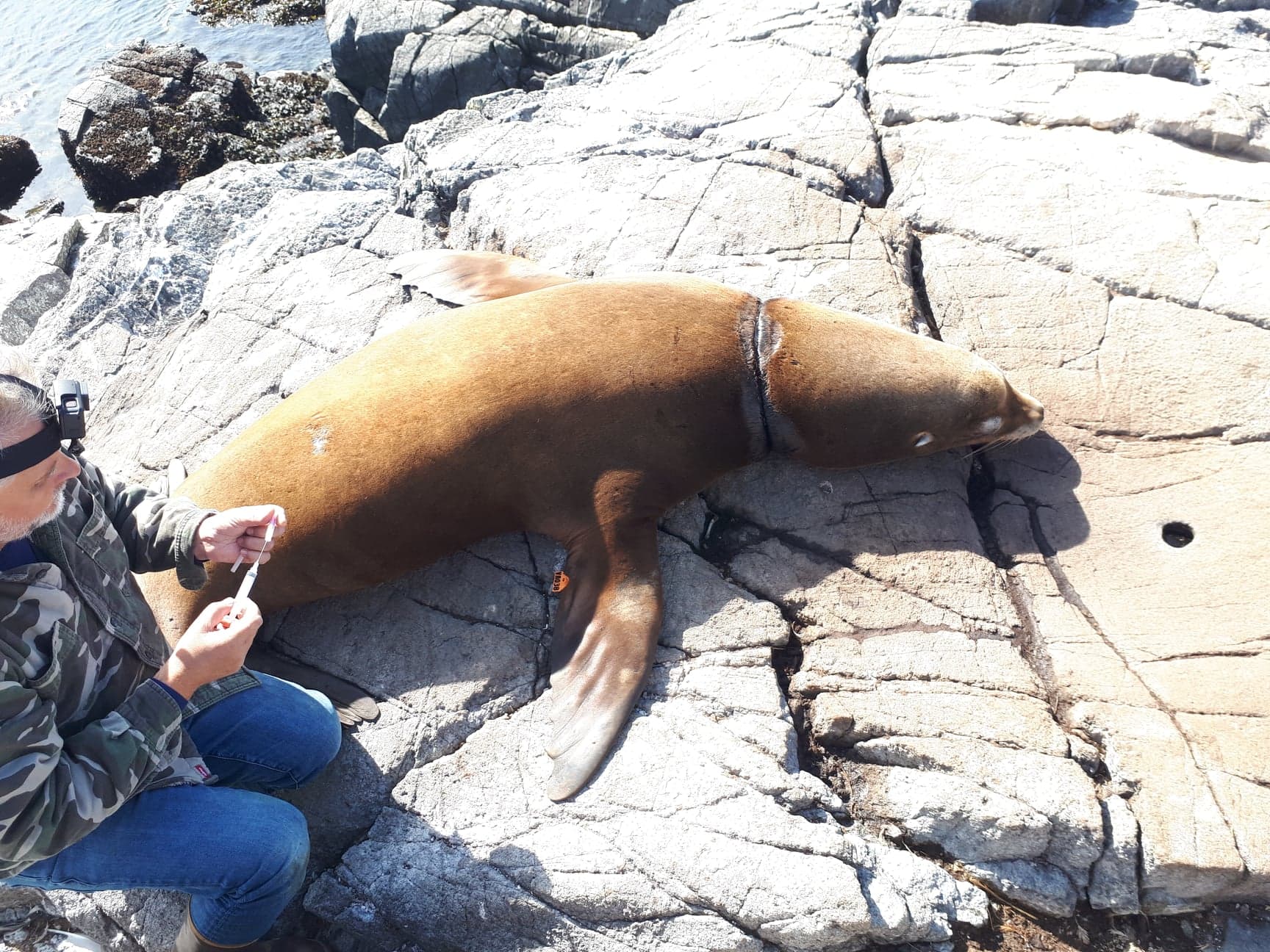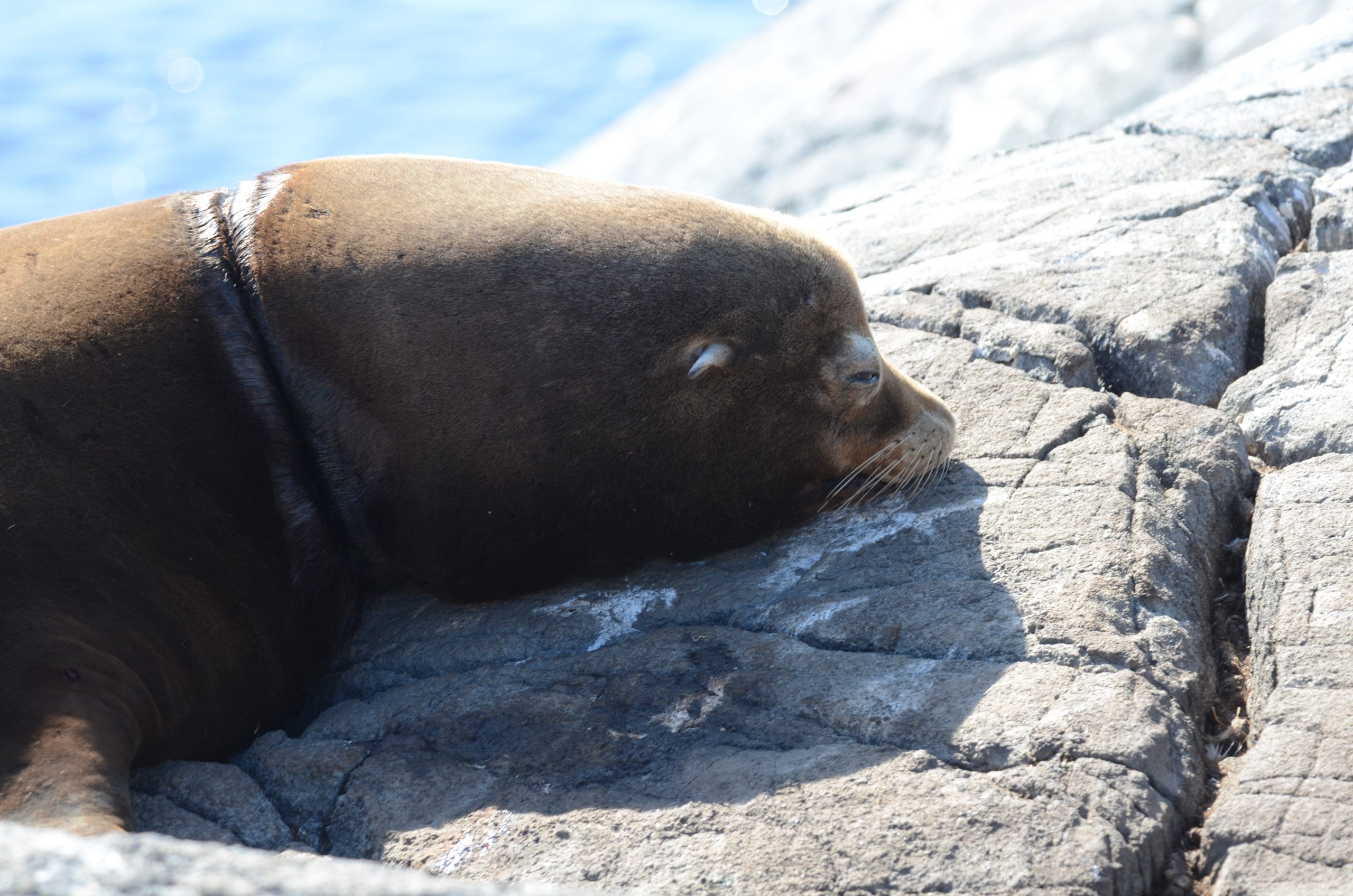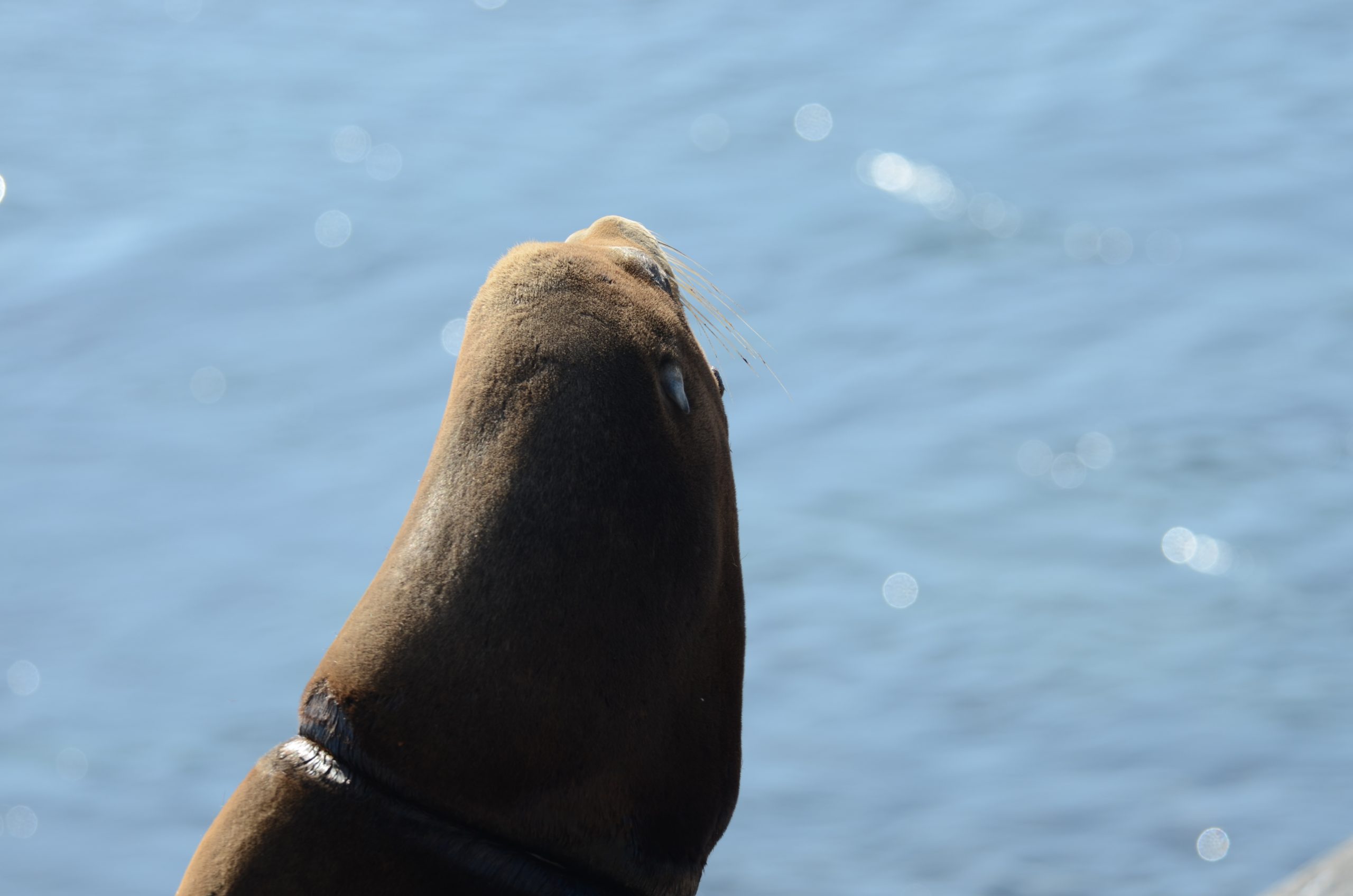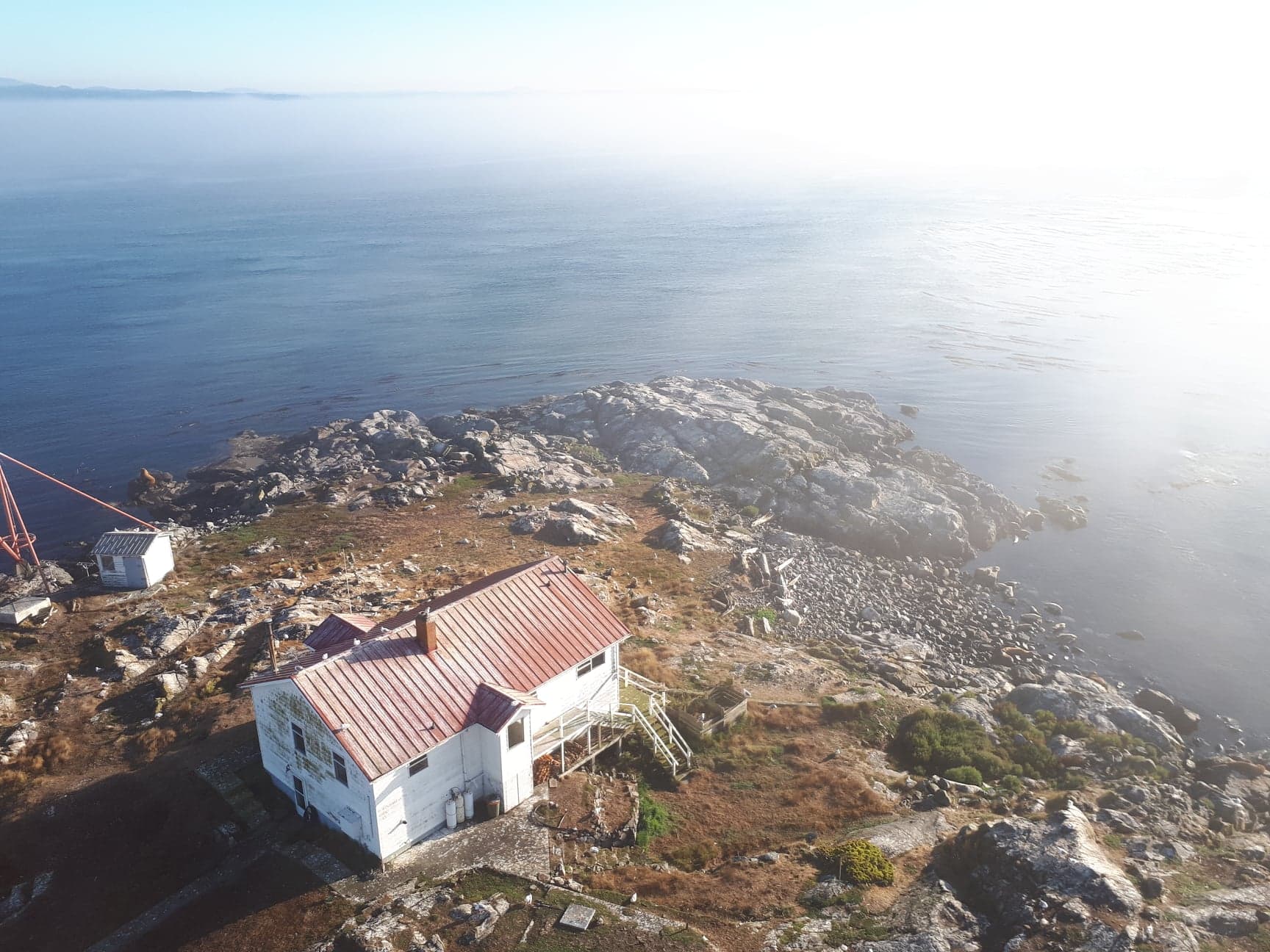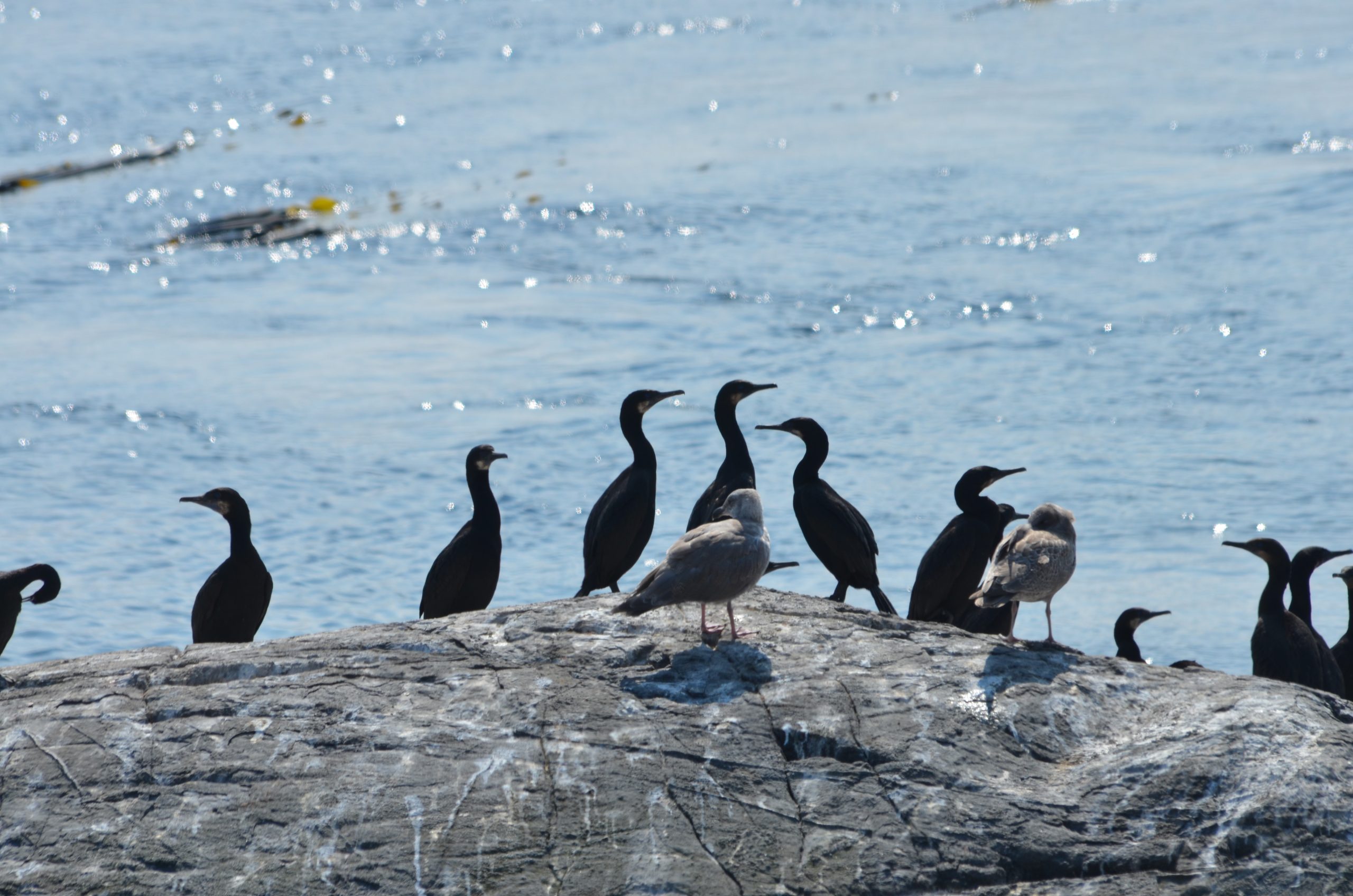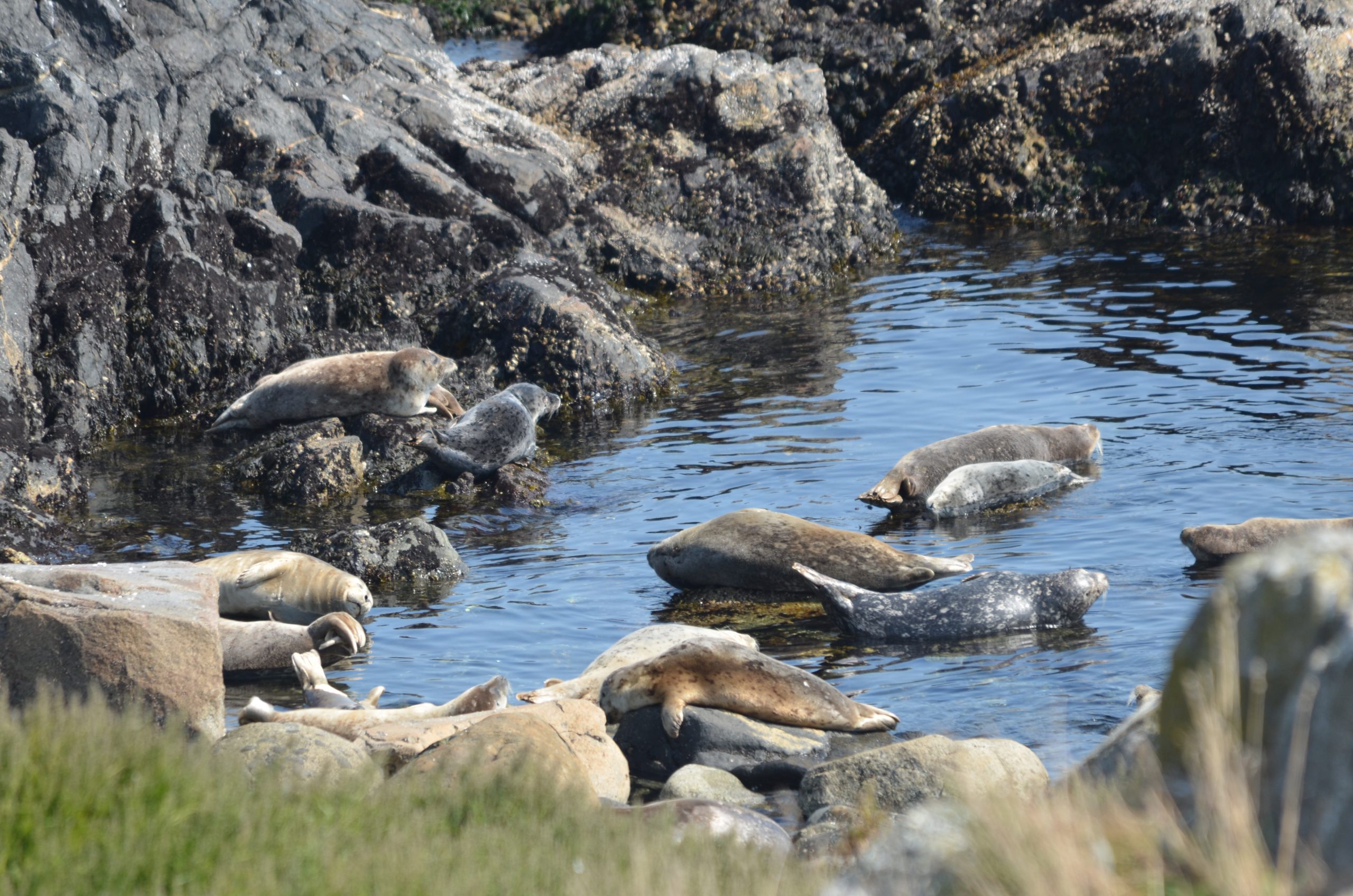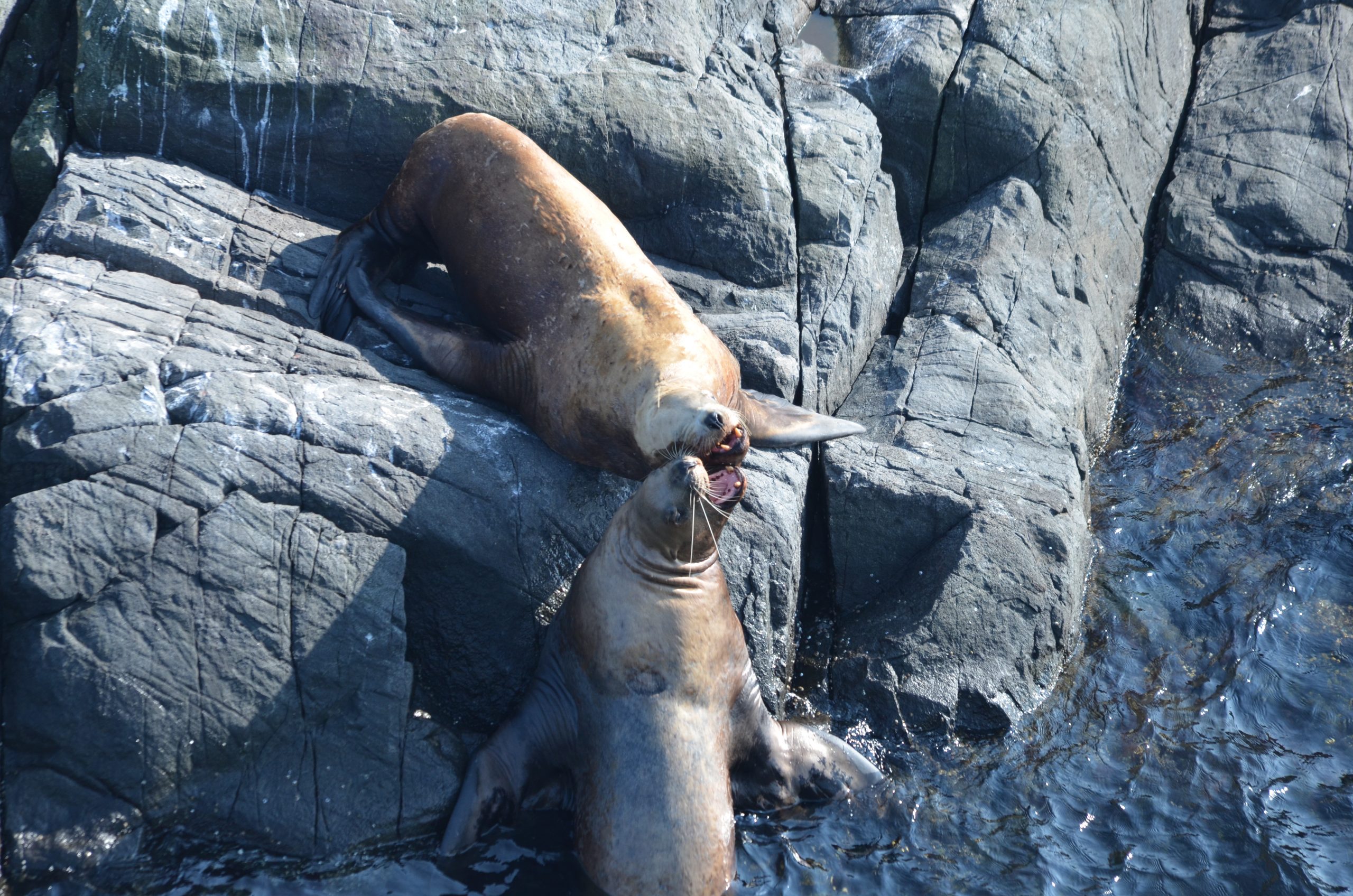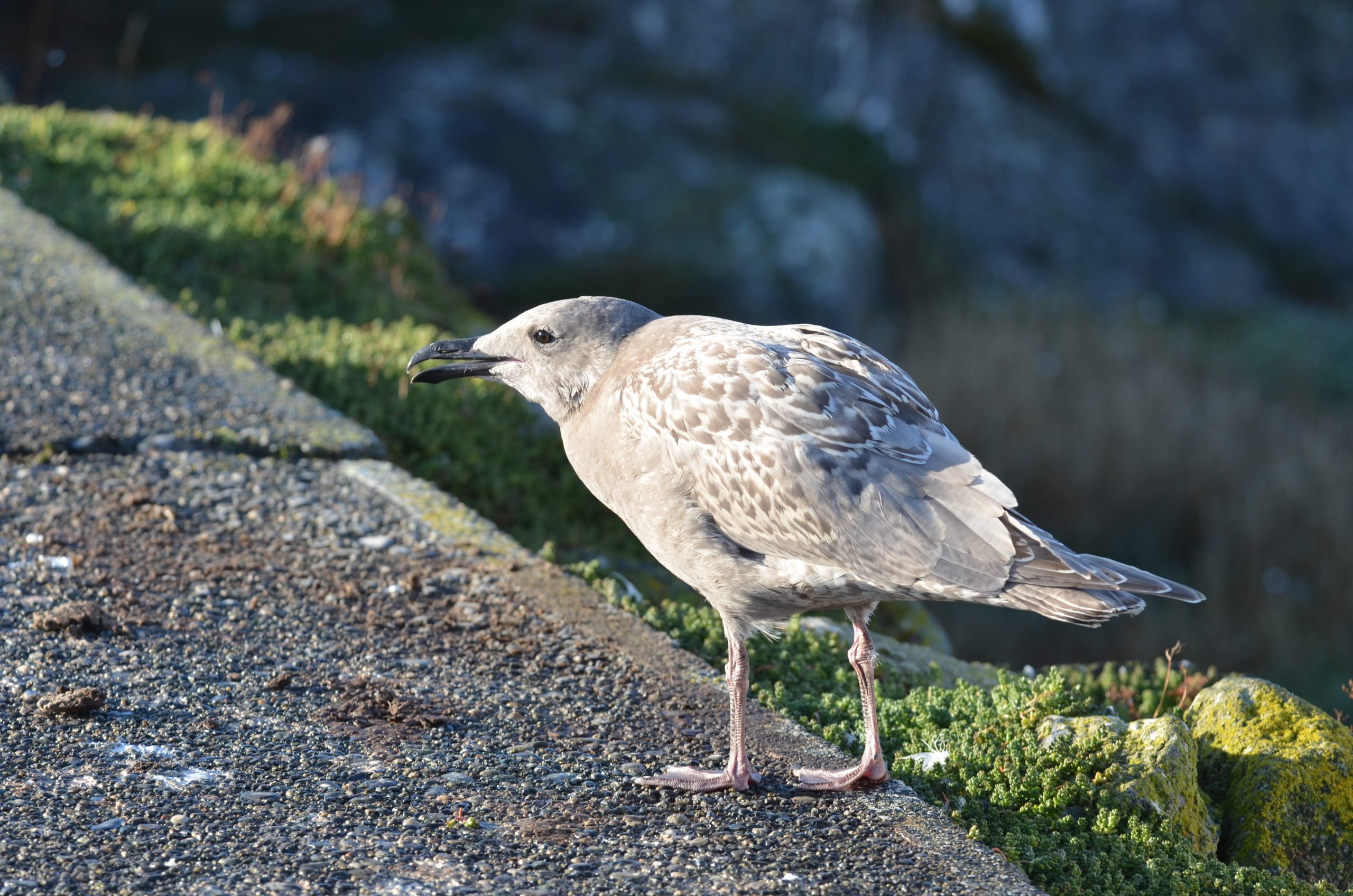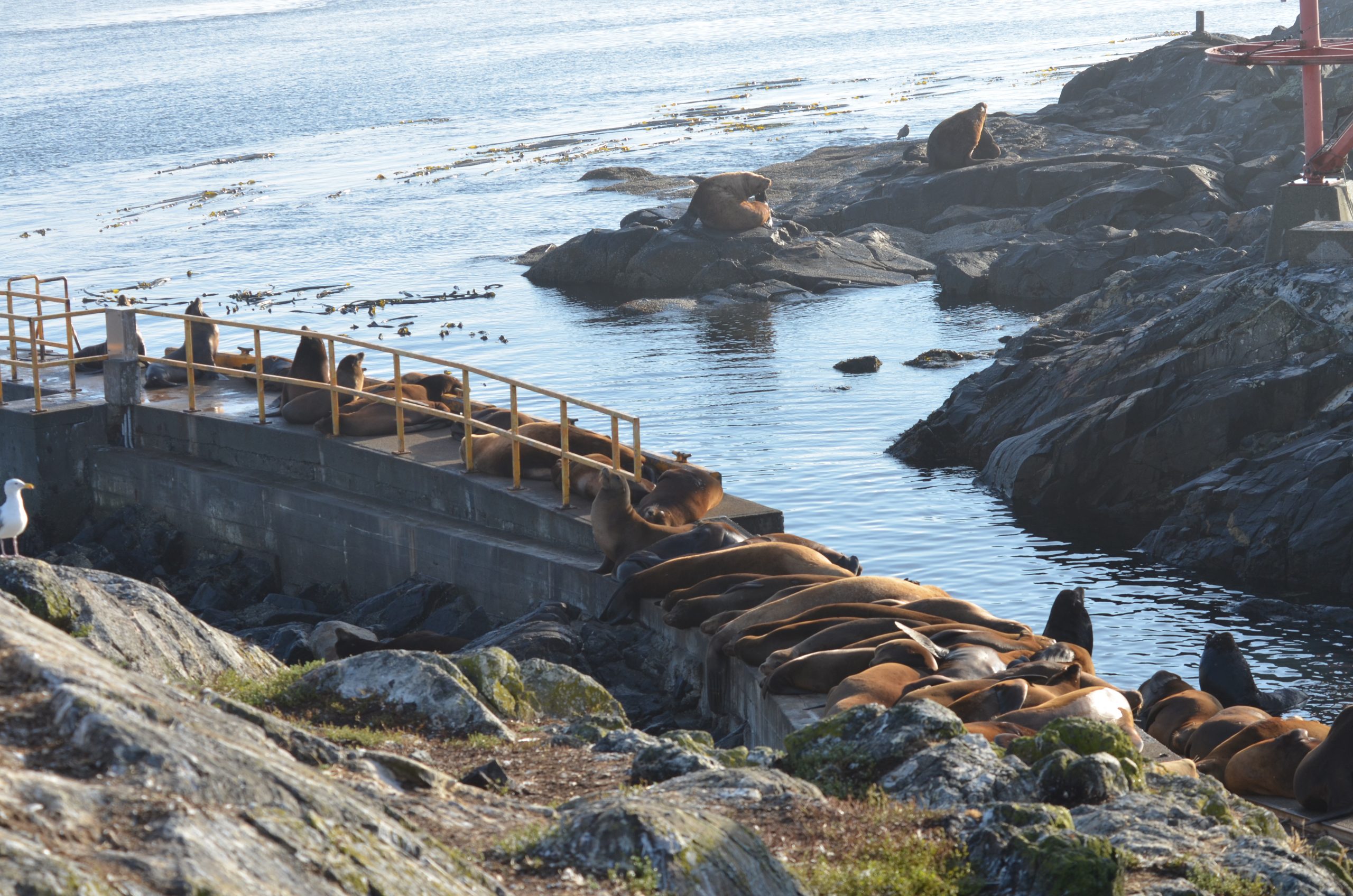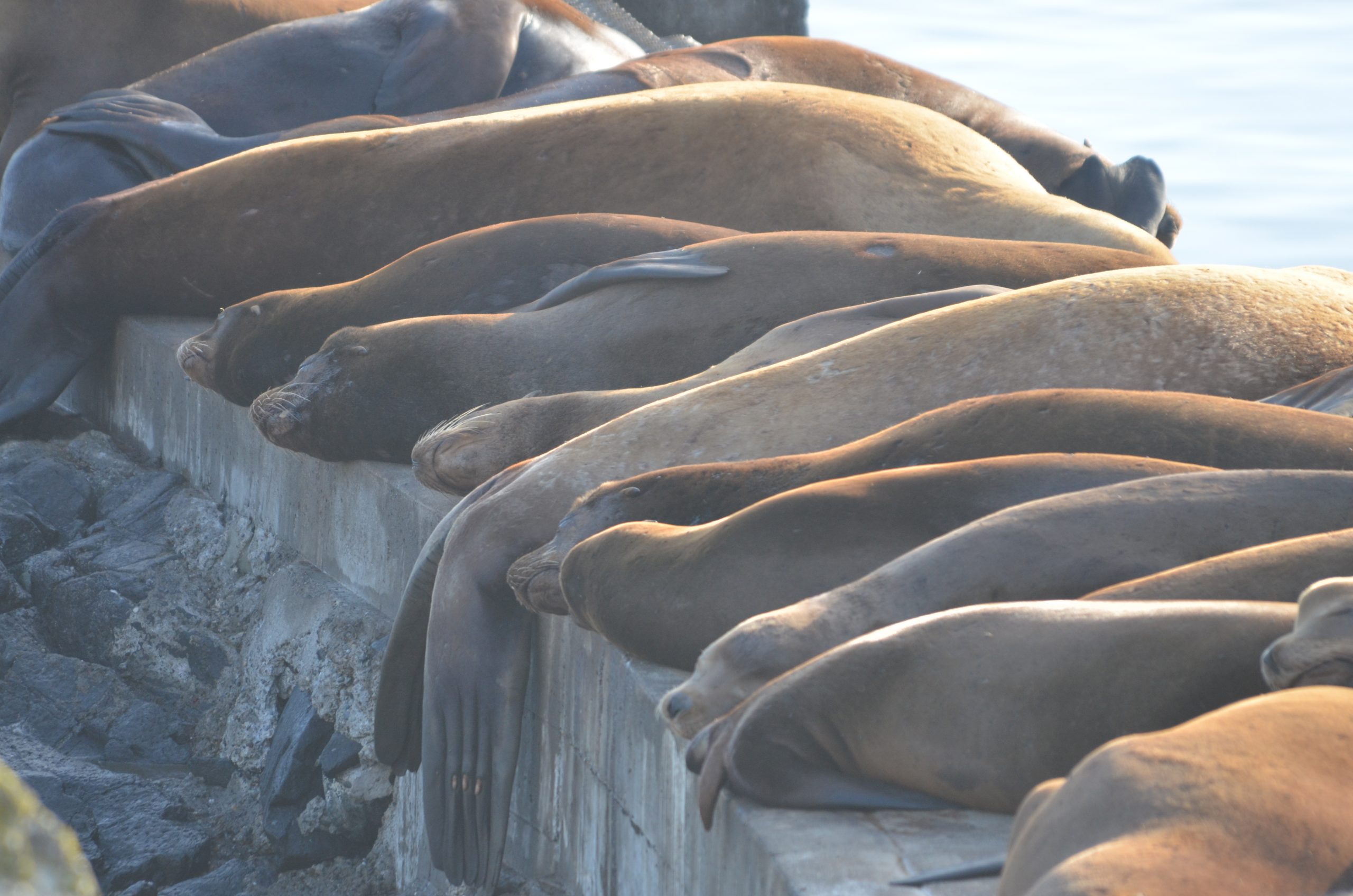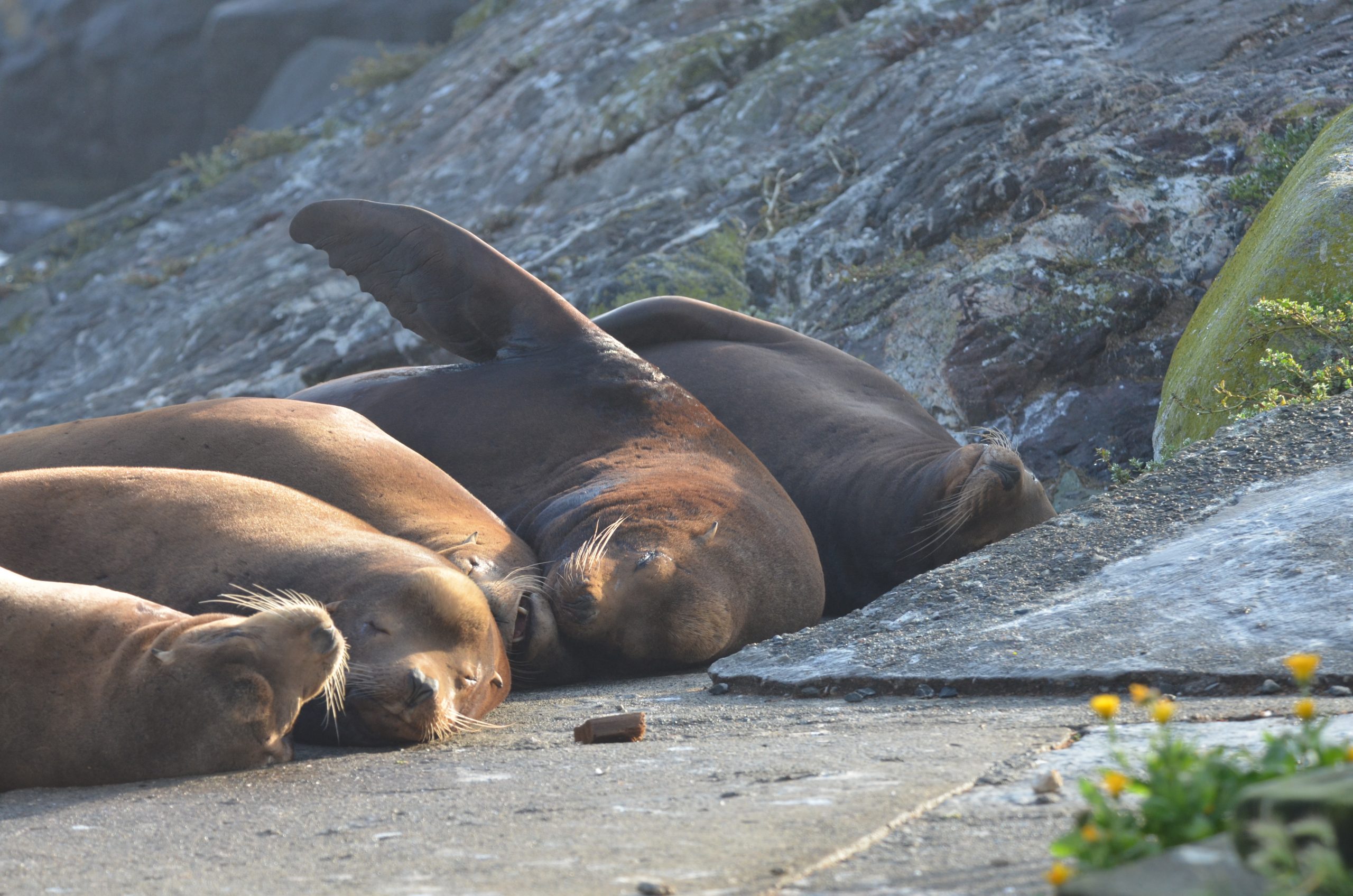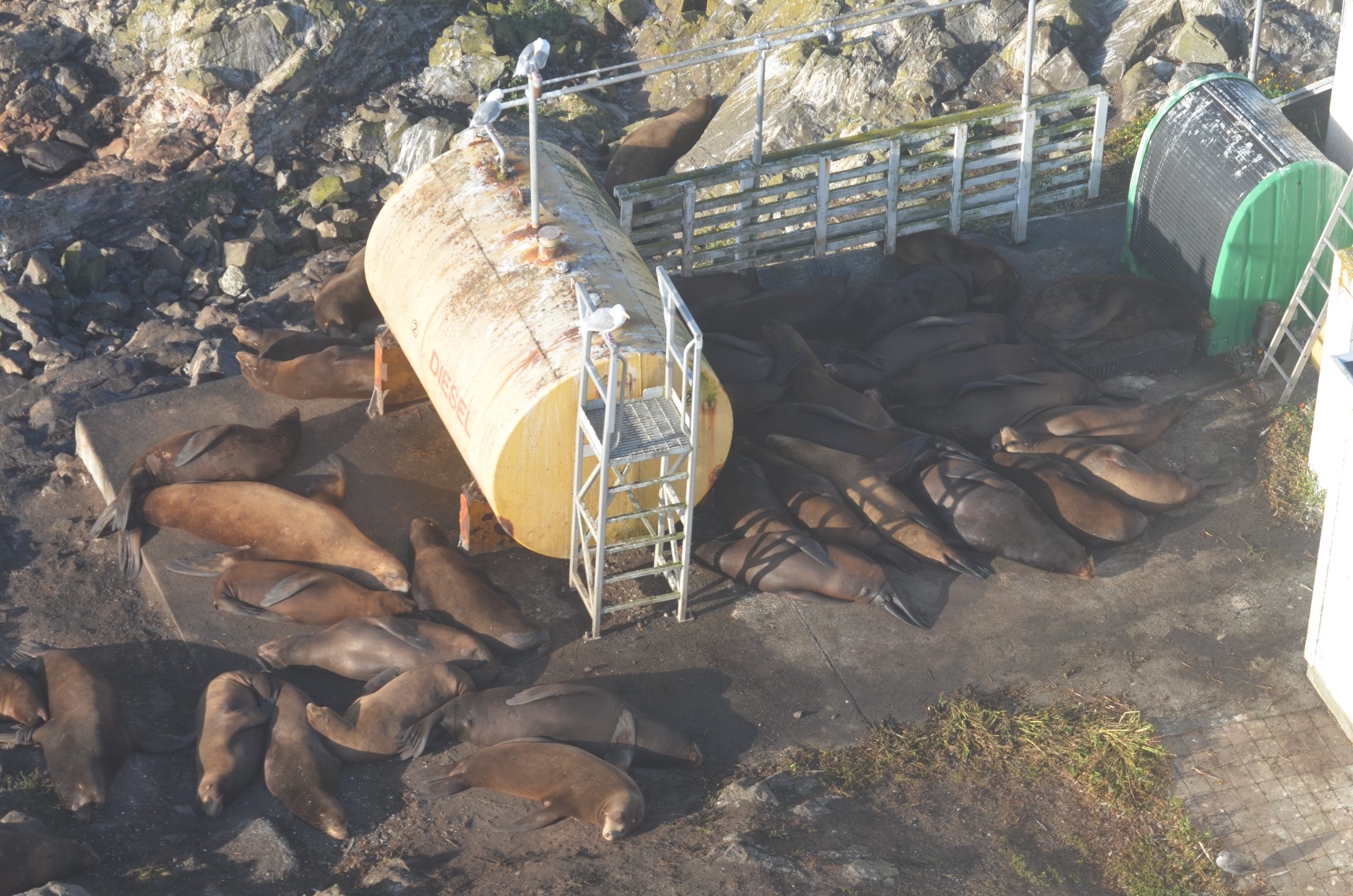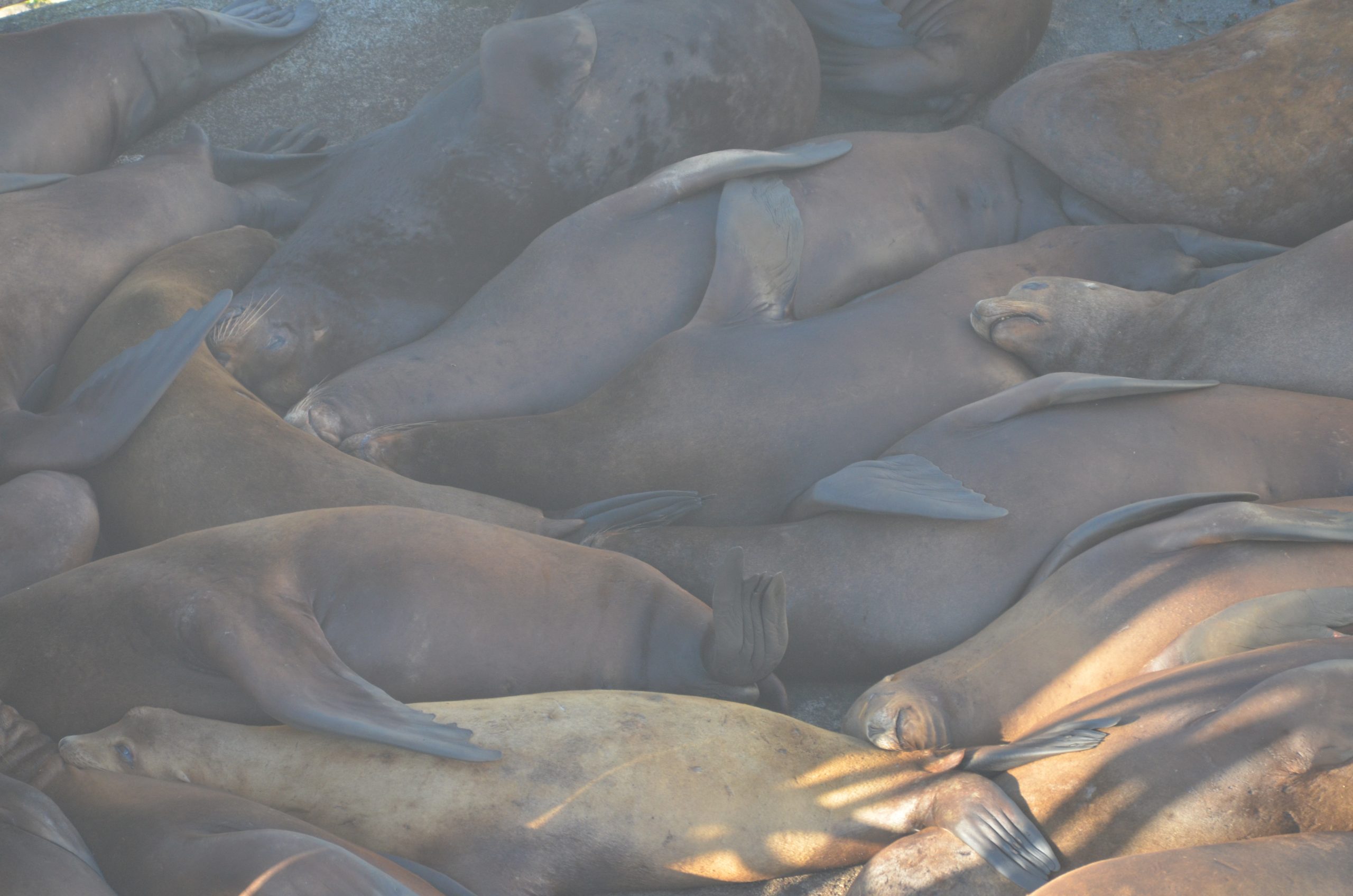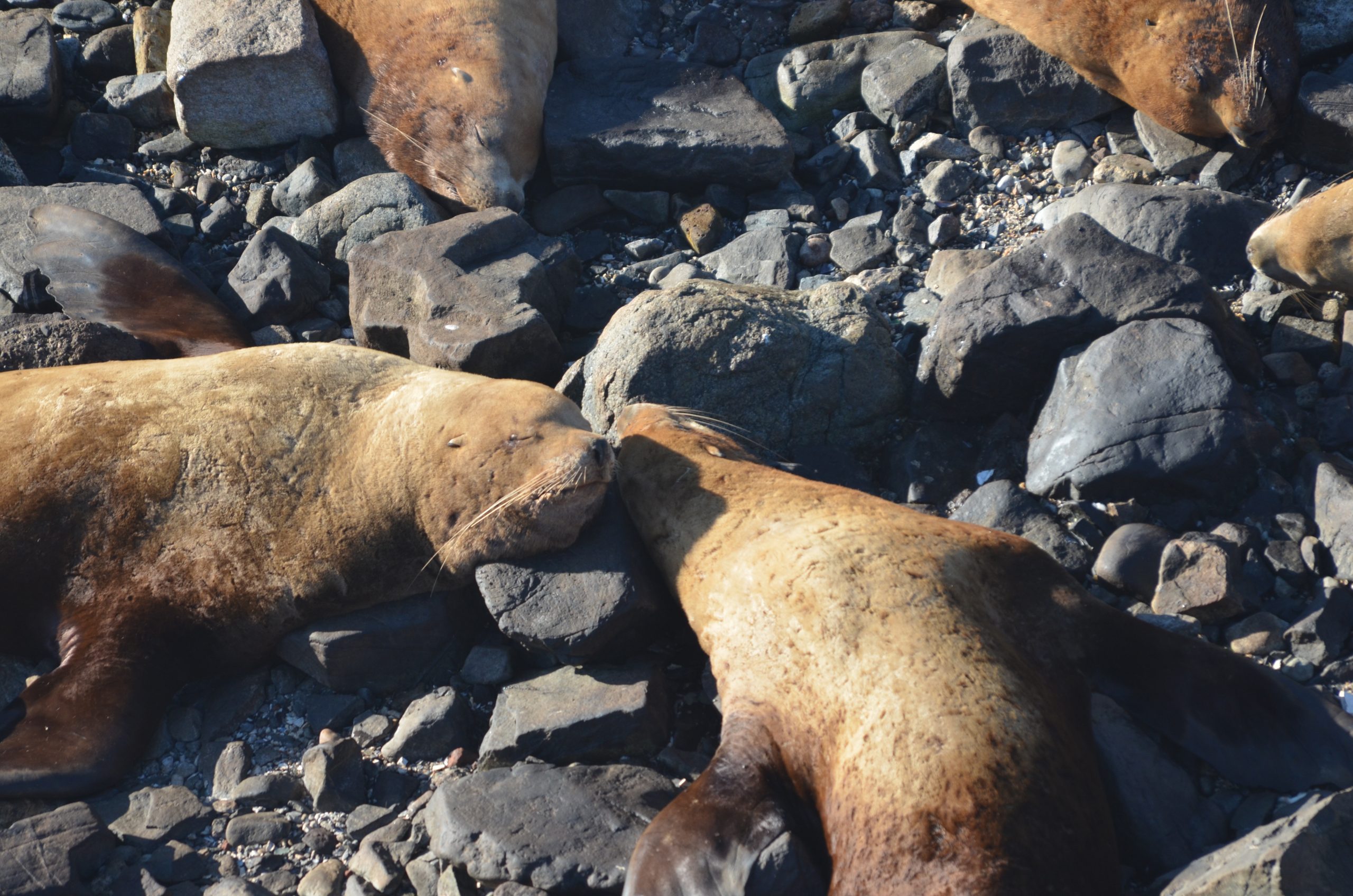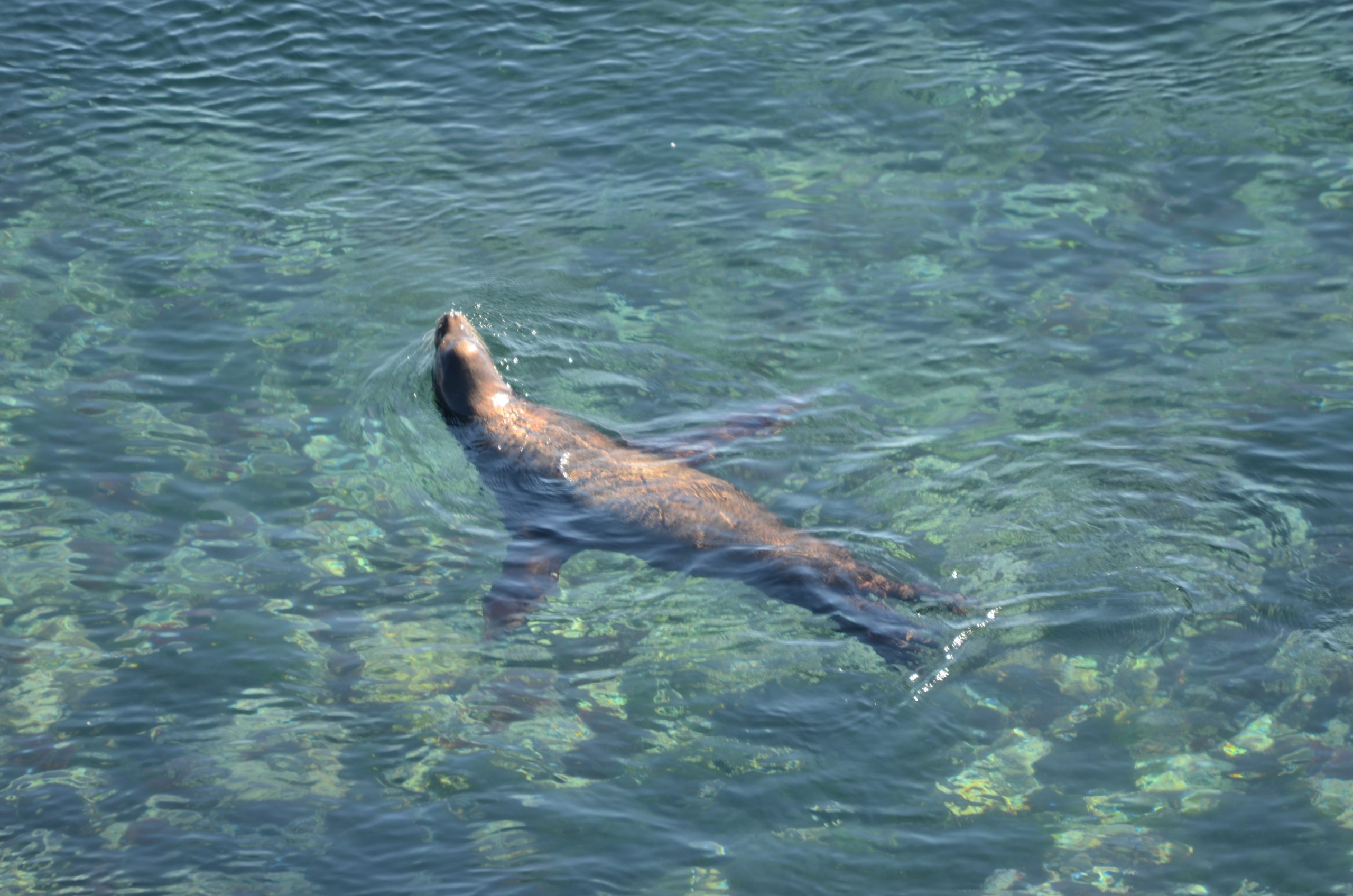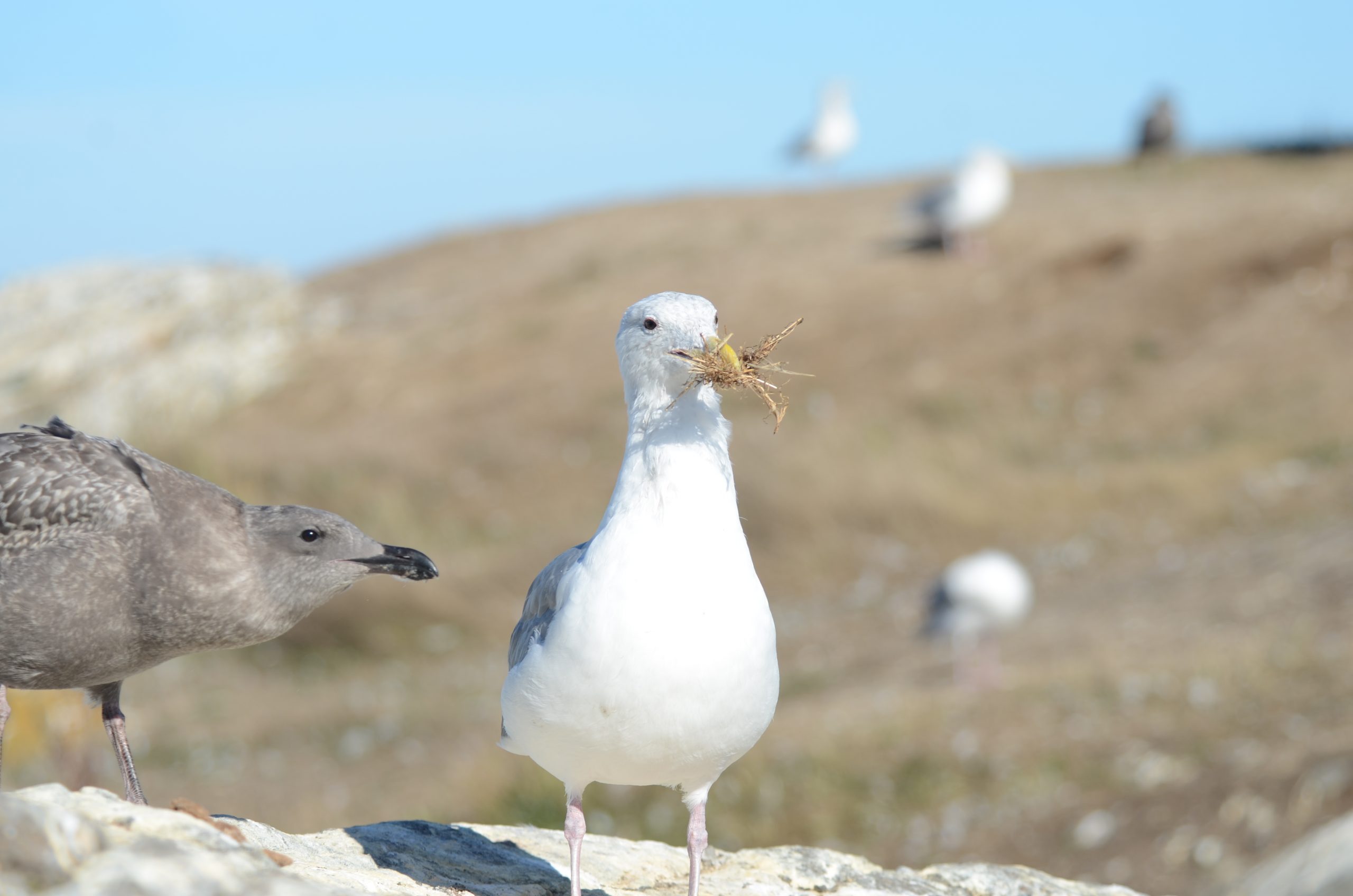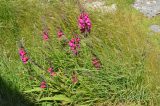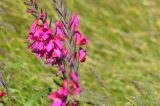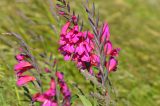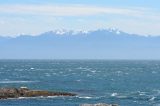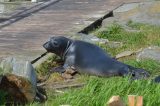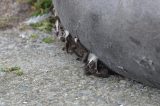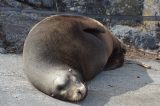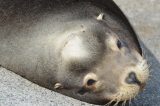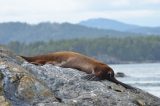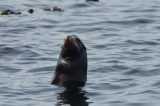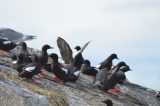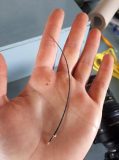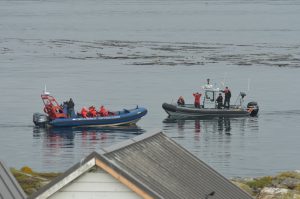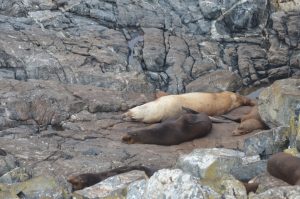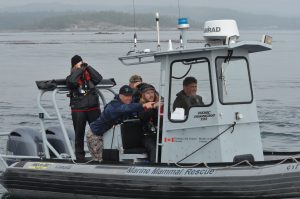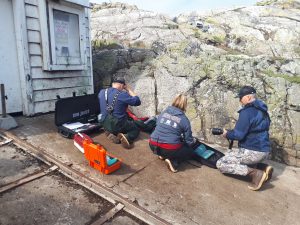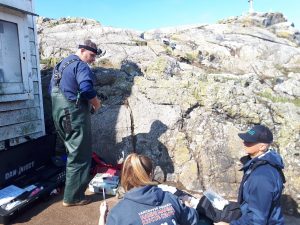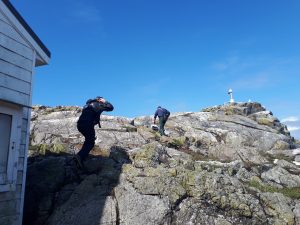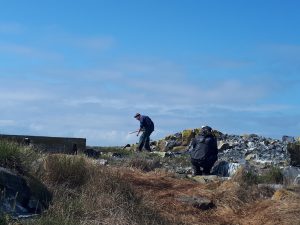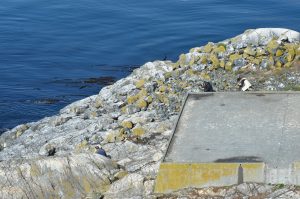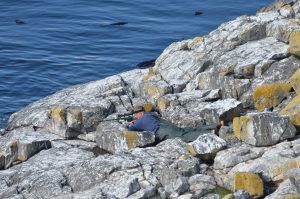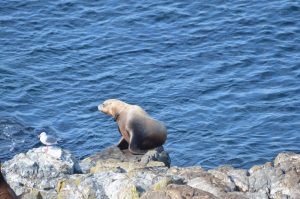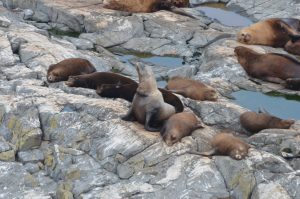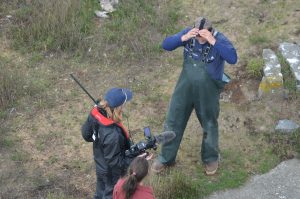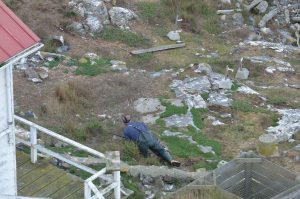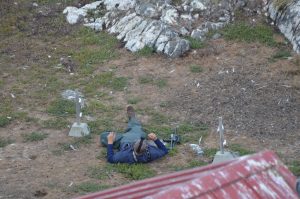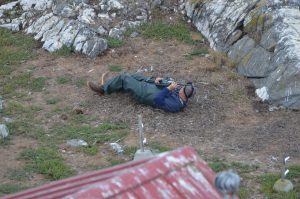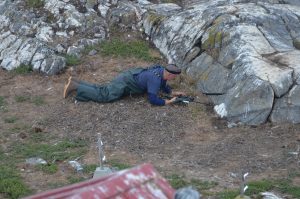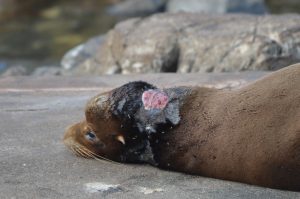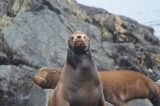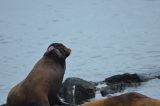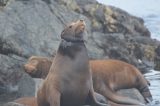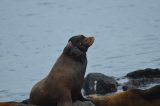Tag Archives: injury
Injured Elphant seal pup
Feb 20 2021 winds west 25.5 knots.
The oldest elephant seal pups mom came back to the boat ramp yesterday. Her pup had bad bite marks on his rump. All day yesterday the gulls would pick at the teeth mark spots on his rump.. I had hoped that he would go to the ocean. After seeing what he was going through it was the safest spot for him. Some time in the night mom and pup swam out to sea. We now have 3 pups 1 female 2 males.
New Ecoguardian at Race Rocks Ecological reserve
Snow and high winds at Race Rocks today
Weather:
Well we got the same dump of snow on February 13th that hit Victoria, arriving with some 40-50 knot outflow winds blowing the crunchy snow all over the place. Estimated about 10cm of snow, but due to the high winds it was moving around lots.
Visitors/Traffic:
No visitors in the last week besides the future Eco-Guardians coming out to do some training. The weather has been consistently >30 knots from Febryary 10th onwards.
Ecological Notes:
With the heavy winds and snowfall the California Sea Lion numbers have been reduced, we thought just for a night or two but the numbers haven’t returned as the snow melts and winds die down. We had 1 California on the jetty looking very sick and emaciated; and one on the South side of the lighthouse with a neckband bleeding pretty heavily.
The Stellers have come back once the snowfall stopped, but weren’t around during the peak snowfall days.
On February 13th we spotted 4 Southern Resident Orca’s cruising their way around the South side of the lighthouse. Talking with local experts it sounds like it was members of J-pod due to local hydrophone recordings.
Elephant Seal update:
On February 11th another pup was weaned and his mom left. This is our 4th pup to be weaned this season, with one still nursing.
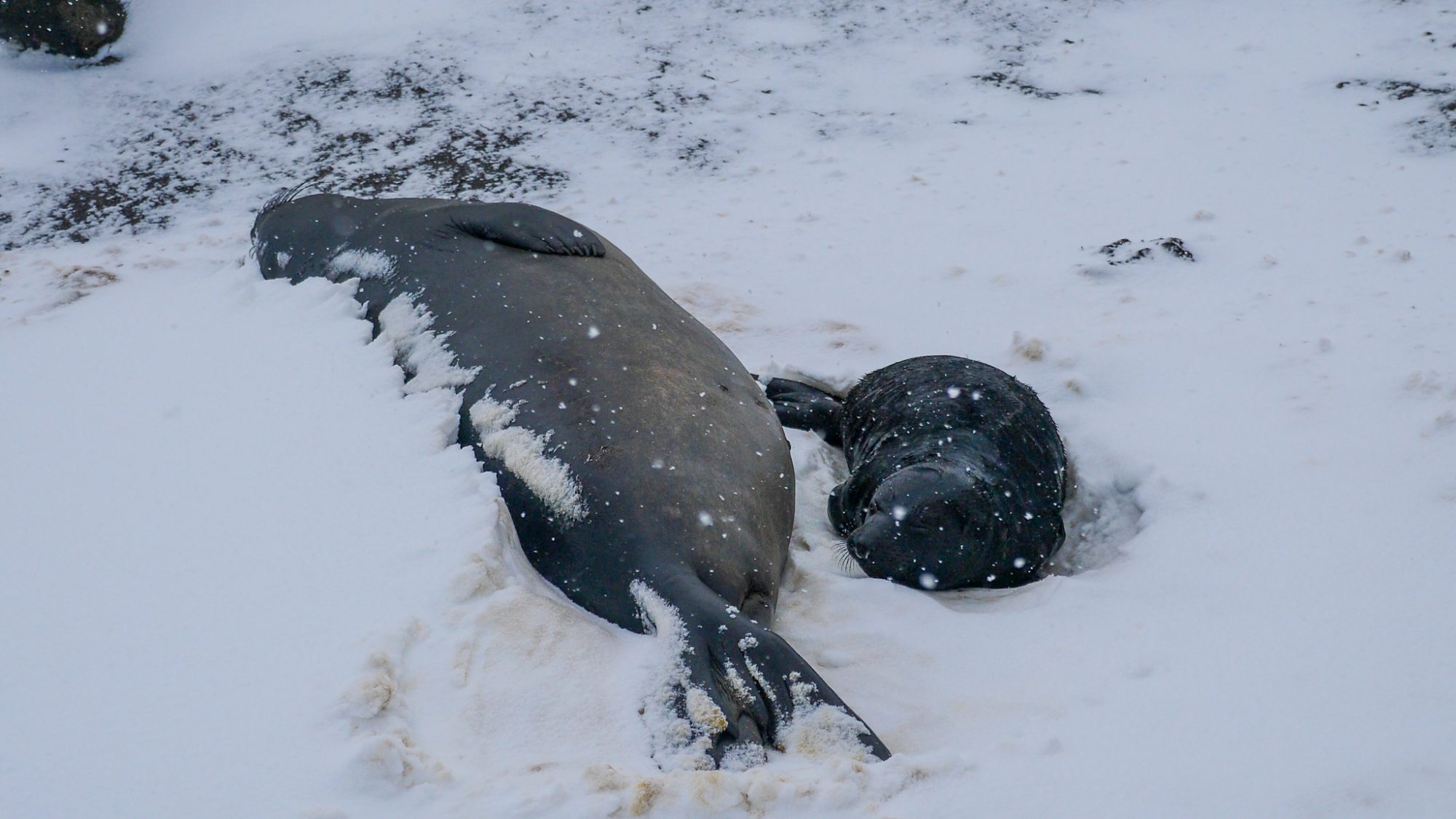
Our last female on the island, Jolene provided a wall to protect her pup from the blasting snowflakes.
Our oldest pup Cheermeister got bit on the head the night of February 7th, and retreated to the front door of the Eco-Guardian house. We thought his bite marks didn’t look that bad despite the amount of blood, but the wound never seemed to clot and may have been much deeper than it initially looked. Cheermeister died the morning of February 11th, and further inspection showed he had 2 deep bites from one of the adult male elephant seals; we assume Jafar the non-Beachmaster hanging out on the island.
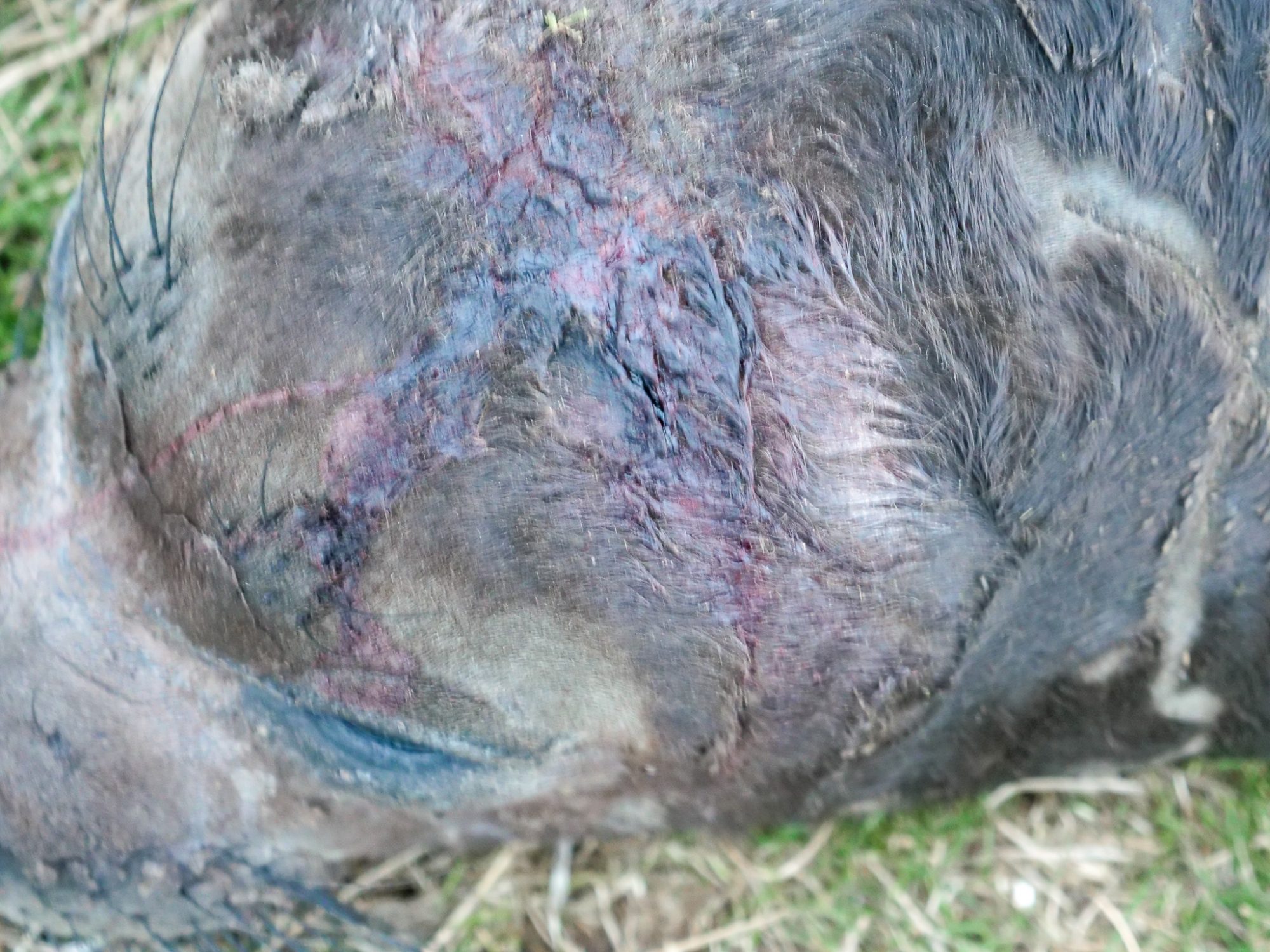
The head wound turned out to be fatal. Pretty crazy to see how much damage they can handle, but the wrong bite in the wrong spot can be enough to kill them.
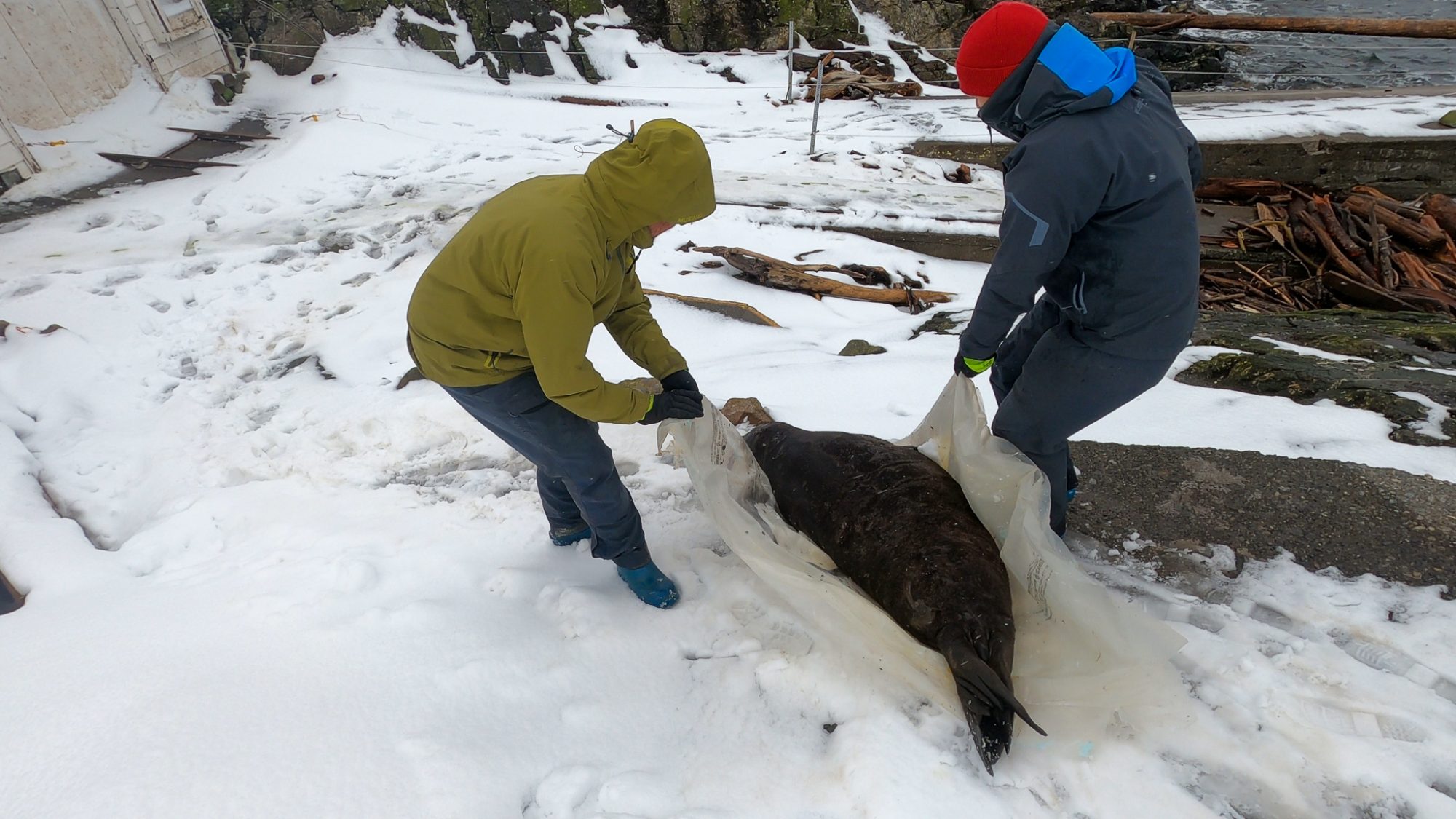
The photos of the seals make them look all cute and cuddly, but they’re actually all over 150kg (330lbs). If it weren’t for the slippery snow he would have been much harder to move.
It’s an interesting thing getting to live in such close proximity to wild animals. You don’t want to interfere in their lives, and sometimes that means watching things that make your stomach churn. Other times things happen and you don’t really know why, and are just left wondering. We are very grateful for our time on Race Rocks, getting to watch these pups be born, grow, and explore the island. Each birth is a celebration of the resiliency of these animals, making their comeback from near extinction.
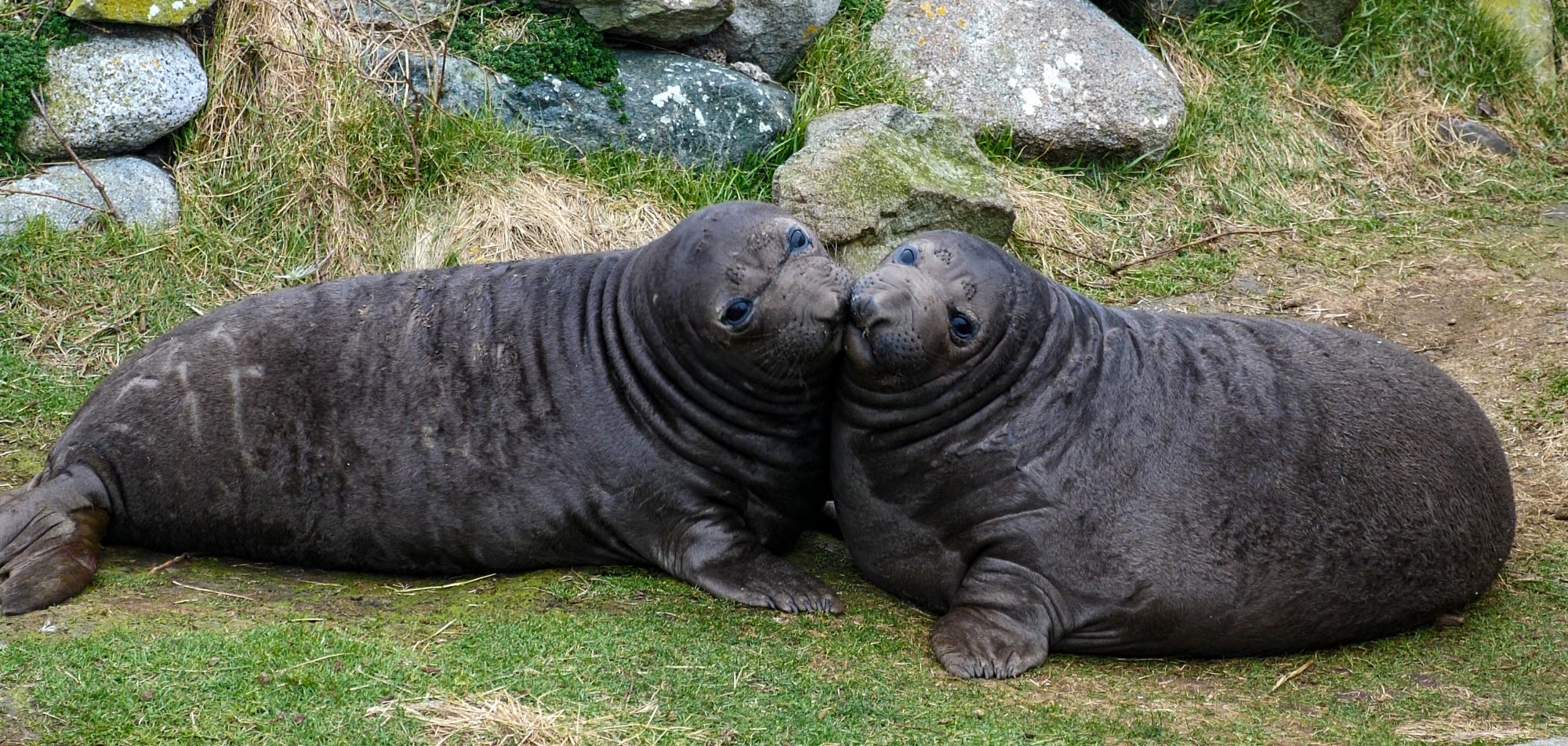
Jellybean and Sebastian have officially ‘podded up’ and are exploring the island together. Too much cuteness.
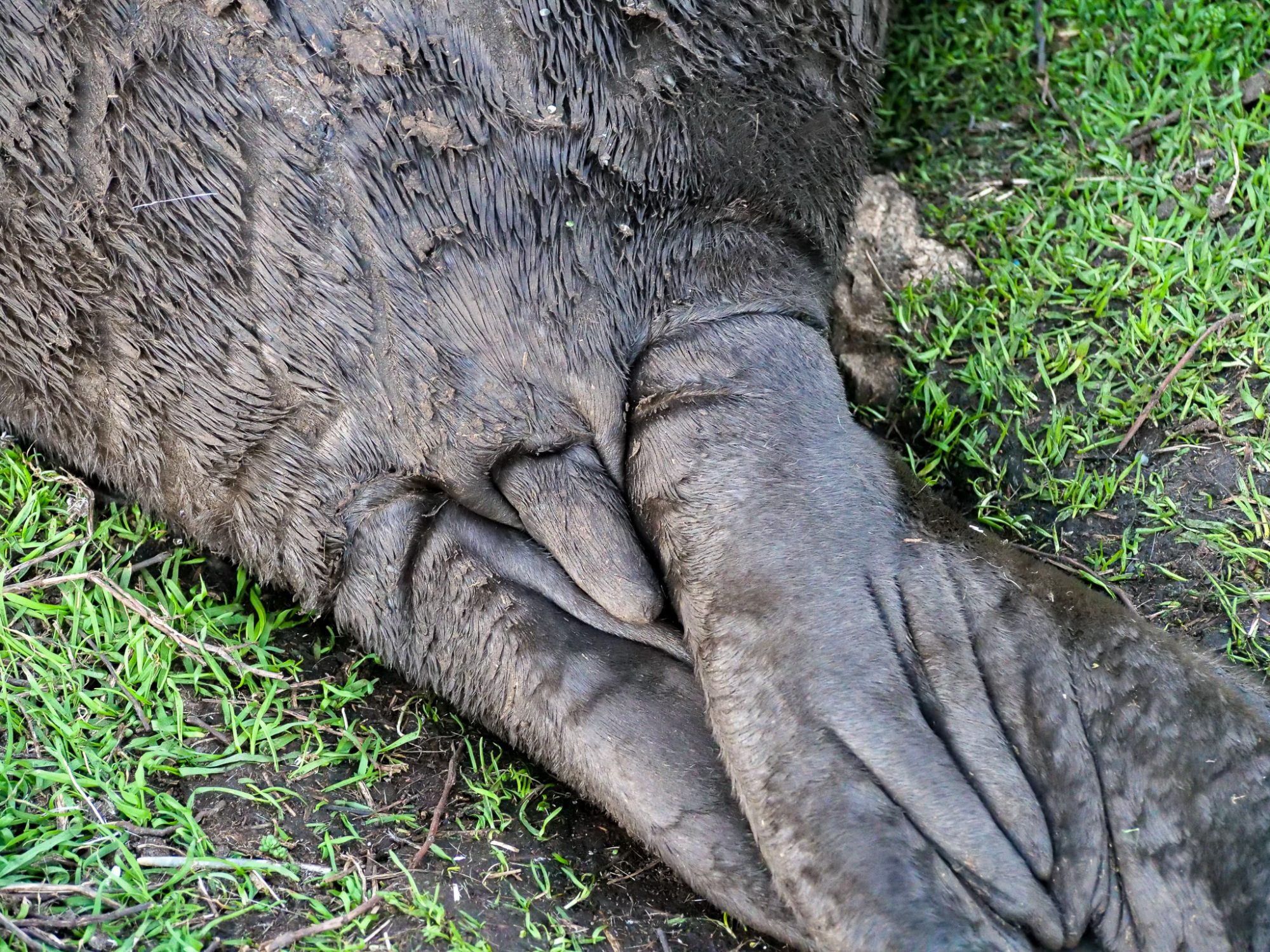
To offset the sadness of Cheery’s death, here’s a Elephant Seal pup’s tail. They’re possibly the most adorable part of the seal.
A Canada Goose Curiosity
Weather Today:
- Visibility 10-15 NM
- Sky overcast
- Wind 20-30 knots NE
- Large swells and some whitecaps
Visitors and traffic:
- There has not been many boats coming through, probably due to the poor conditions.
Notes:
- The weather since our last post was very rough, we had winds of over 50 knots (about 100km/h) and some very rough surface conditions.
- We have been having some equipment issues but we are back and have some great photos to share!
- On Saturday we spotted an oddity – a Canada Goose with a mostly white neck. It really stood out from the rest of its feathered friends and it was a rush to the camera for us. We think it may be leucistic. Leucism is not one specific condition, and this ‘depigmentation’ probably has an underlying genetic cause.
- We have seen a variety of eagle but most exciting was the bird about 20 feet in front of the house, perched on top of a freshly caught seagull!
- On Sunday a seagull with a badly injured and nearly missing wing was around, perhaps the result of a predator attack gone badly for both parties. It was completely alert and walking around with the other seagulls but we haven’t seen it since and presumably it succumbed to its injuries or predation.
- Canadian Coast Guard Ship John Cabot, an offshore fisheries science vessel, paid the area a visit. The vessel hung around for about an hour and looked to be doing something with a lifeboat, maybe training? CCGS John Cabot was just recently constructed at Seaspan Shipyards and was launched in July, champagne bottle and all, by provincial health officer Dr. Bonnie Henry.
- Visibility has been erratic – we will have a census posted when first possible.
- Leucistic Canada Goose (1)
- Contrast with a regular goose. (2)
- (3)
- An eagle eating a freshly caught seagull. (1)
- We were spotted… (2)
- A perching eagle.
- A predator looks to have taken a bite, but this seagull escaped… minus a wing. Ouch!
- CCGS John Cabot, and an enclosed style life boat. (1)
- The lifeboat is hoisted back on board the ship. (2)
- A beautiful moment as the sun comes through the clouds.
- It looks like these sea lions don’t mind each others company.
- The bones of a deceased seagull protruding from the mud, this is probably the remains of a chick from nesting season earlier this year.
- A dunlin foraging for food.
- Look at those little sealions!
- Sometimes life as a sea lion can look appealing.
- Cormorants perching close together.
- It looks as though this large group of seagulls is feeding on something in the water.
- A float of some sort in the water near a kelp patch, this could be lost fishing/crabbing equipment.
- With rain comes fresh water. These geese seem to prefer drinking and bathing in fresh water but can drink some salt water.
Successful Sea Lion Rescue!
Weather:
- Sky Clear and blue
- Visibility 15+ NM
- Wind 20-25 knots NE
- Sea state: swells up to one meter
- Temperature outside: 19.8 C
- Pressure: 1021 hPa (decreasing)
- We have been seeing consistent fog in the late evening, lasting for an average of 2 hrs. The fog banks seem to move over us from Port Angeles.
Visitors:
- Marine Mammal Rescue and DFO visited yesterday (more on this below).
- Steady flow of pleasure crafts and whale watching vessels over the long weekend.
Sea Lion Disentanglement:
- Yesterday Marine Mammal Rescue along with the support of DFO vessels and staff came to help a sea lion with a plastic packing band stuck around his neck. They were able to successfully dart the sea lion with a tranquilizer injection, remove the band, give him tracking tags on his front flippers, and take a blood sample. When this was done they injected a reversal drug to wake him up and with a little scratch he was back on his way!
- Sea lion with plastic packing band entanglement
- DFO and MMR arriving
- DFO aided in the search for other entanglements with their drone
- Preparing a dose of tranquilizer
- Marty (veterinarian, MMR) getting close to take his shot
- The dart can be seen on the right side of the sea lion
- Removing the plastic!
- Adding tags to his front flippers and taking a blood sample
- Waking up after the reversal injection
- Much better!
Ecological Notes:
- The seagull chicks have officially flown the coop! Only a few remain and we are able to move around the island again without bothering the nesting birds.
- This year we have noticed significantly less trash left behind by seagulls than last year. Our best guess is that they had more food available to them this summer, which would also align with observing them regurgitating much more fish that the previous season.
- The sea lions have been increasing in numbers every day. The new fencing material that Nick and Greg used seems to be working much better than the wire that we tried last year, preventing them from damaging the island infrastructure. We have been letting them rest on the jetty this week but we will soon need to install more fencing in preparation for student visits.
- Yesterday we found two turnstones which appeared to have been killed by the gulls while we were investigating the area near the codar antenna (SW Great Race Rock).
- Foggy morning yesterday
- Cormorants on seal rock
- harbour seals on E side of Great Rock
- Sea lions challenging each other for the highest rock!
- Sea lions sleeping in (1)
- (2)
- (3)
- (4)
- (5)
- (6)
- (7)
- Beautiful clear waters yesterday
- Gull and chick
Windy Windy Spring Weather
Weather:
- Visibility 8-10 NM
- Sky overcast
- Wind 35-40 knots W
- Sea state: large swells and chop, breaking at 1m
Visitors/Marine Traffic:
- No marine traffic today as it has been very windy
- Greg and a technician came on Wednesday
- Garry and a visitor came yesterday evening
Ecological:
- there is one elephant seal now. She spends most of her time near the fuel shed, or on the jetty near “Boris” the sea lion (with the propeller injury on his head).
- The seagulls have been fighting quite a bit now that their population is becoming denser and space is limited. The male seagulls fight more often, and their female mates are usually nearby observing.
- Turkish Marsh Gladiolus
- This branded sea lion is 13 years old
Windy Week and Sea Lion Update!
Weather:
- Visibility 15+ NM
- Sky clear
- Wind 15-20 knots W
- Sea state: calm, rippled
- It has been very windy this week. Most days the wind has hovered around 30 knots, sometimes as much as 35+ knots! It has been overcast intermittently, and we did receive some rainfall.
Visitors/Marine Traffic:
- Greg visited today with some supplies. Thanks Greg!
- Since it has been so windy, there has been very little boat traffic. Yesterday we saw one small pleasure craft playing in the waves near Pedder Bay, and one coastguard ship passed by earlier today. A few small vessels and fishing boats passed by but no vessels entered the reserve.
Ecological:
- Animal activity has been very quiet due to our stormy weather
- The geese seem to be moving on now- there are fewer every day.
- There are not many more seagull nests beginning but the seagulls have chosen their nesting locations and are defending them from other breeding pairs.
- There is one sea lion who has been coming onto the jetty and does not move away from us as the others do. We believe this is the same one that we observed last year who seemed to have a propeller injury on his head. It’s interesting that he has been able to survive with seemingly quite a bit of behavioral impact due to the head trauma.
- Coastguard ship passing by Rocky Point DND land
- This little one is a new arrival. We look foward to learning more.
- (here is a closer view of the tag)
- Moulting elephant seal
- The sea lion with scar on head
- Closer view
- Interesting patchiness on some of the sea lions
- Pigeon Guillemots
- Elephant seal whisker!
Sea Lion Rescued from Plastic Entanglement
A team comprised of the DFO and Vancouver Aquariums Marine Mammal Rescue (MMR) came out to Race Rocks on September 16th to help the entangled sea lions we’ve spotted over the last few weeks. Leaving from Pedder Bay at 0900, they arrived in two RHIBs at the reserve shortly after. After observing the struggling animals over the last while and communicating information with MMR, they were a welcomed sight.
- MMR and DFO arrive at the edge of the reserve.
- An eco tourism boat encounters the DFO support vessel in front of the jetty.
Right away we spotted three possibly entangled sea lions from the lighthouse (unfortunately none of these three being the animals we photographed previously). We then landed the team of vet techs and veterinarian Marty at the jetty to assess the situation. It was decided that one of the sea lions resting by the water between the guest house and the helicopter pad was our best rescue candidate.
- The entangled sea lion.
- Visual contact from the water!
Marty and a videographer from Vancouver Aquarium approached over the helicopter pad from the direction of ‘Camera 5’. They got into position and a shot was taken, but the tranquilizer dart bounced and the sea lion fled into the water.
- Preparing the tranquilizer.
- The sea lion was estimated to weigh 500kg, and the dose had to be measured accordingly.
- (1) Heading towards the helicopter pad.
- (2)
- Marty gets into position below the helicopter pad.
- Lining up the shot with the tranquilizer gun.
- (1) Another angle of the sea lion
- (2)
From the lighthouse we were able to follow its movements and keep the team apprised by radio. There was uncertainty about whether or not it received a partial dose of the tranquilizer as it floated in strange positions/patterns. Moving around Race Rocks to the water beside the solar panel/generator building, it hauled out again and another shot at it was lined up from one of the boats. The angle wasn’t quite right, and it again fled into the ocean and couldn’t be spotted. It was around 1400, and everyone took a break to have some food.
After this, everyone considered calling it off as it was getting late and we couldn’t locate the animal. At the last moment, with both boats ready to head back to Pedder Bay, it was spotted from the lighthouse (resting on the rock mound on the NW point of Great Race Rock)! Tranquilizing was attempted from water, but the dart bounced again and landed in the water and was recovered. Here’s a short video of that:
After that, it ended up too far from the water to try another shot by boat, so in a final effort the one boat landed Marty and the team again while the other stayed on the water to support. With no cover available between him and the animal, Marty had no choice but to crawl about one hundred feet in order to take the shot.
- The sea lion is sighted again on the point of NW Race Rock.
- MMR team gets back onto land.
- Gearing up for the land approach. Hopefully some good video was captured!
- Marty moves over challenging terrain near our compost bins, staying low while managing to carry the large tranquilizer gun.
- (1) The electric fence was off, but it still was an obstacle as standing would have frightened the surrounding sea lions into the ocean!
- (2)
- (3)
We were able to capture the following footage of the sea lion being darted, going into the water, and then after a tense 20 minutes during which a pod of transient orcas appeared in the reserve (who sometimes eat sea lions), it was found! The team proceeded to cradle the animal between their vessels and remove the plastic band. Then, they injected a reversal drug to reverse the tranquilizer before letting it go.
Everyone was relieved to have successfully helped an animal in need. We have suggested that future disentanglement efforts might have a better chance if extended to overnight stays in the guest house, and perhaps coordinated and executed in a more timely manner in relation to the animal sighting(s). This time we were unable to find the original animals that we had previously spotted, since it took quite a while to organize the rescue attempt. A big thank you to everyone who came to help this sea lion and teach us about their work!
Check out rescue.ocean.org to learn more about the Vancouver Aquarium Marine Mammal Rescue program, and Ocean Wise.
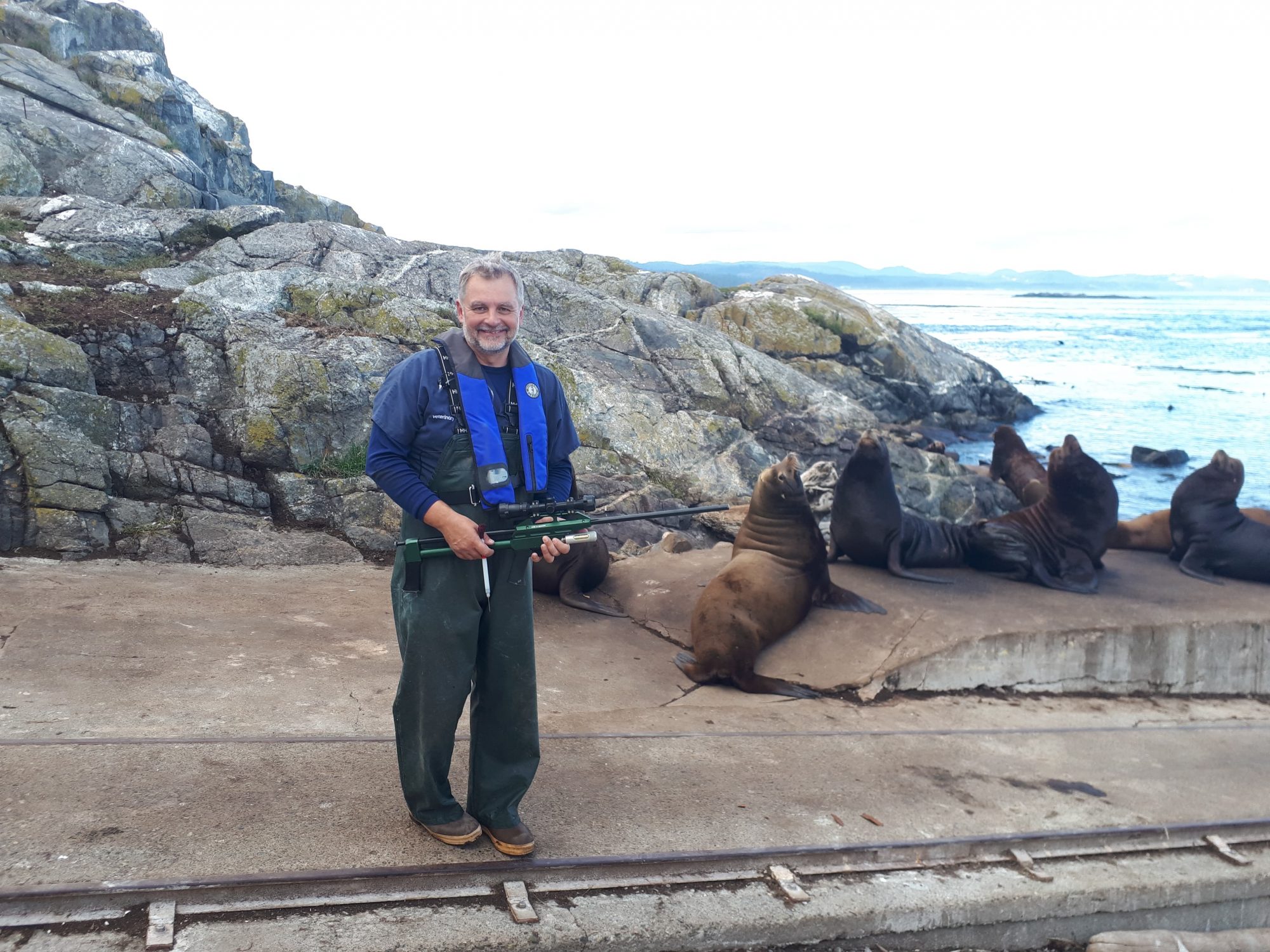
Thanks to the rescue team, one more sea lion has a better chance of survival! (vet Marty holding the dart gun and dart used to tranquilize the sea lion)
See media coverage: https://www.bclocalnews.com/news/plastic-band-removed-from-neck-of-greater-victoria-sea-lion-2/
Plastic Pollution Strikes Again, Injured Sea Lion
Today we saw another entangled sea lion hauled out near the jetty. It appears to be wrapped in fishing line, which has embedded itself in the sea lions flesh over time causing infection/rotting.
Seeing these injured animals is a reminder that improperly disposing of garbage, fishing (cut/broken lines, lost nets, etc.), and other ecologically detrimental human activities causes the suffering and death of large (and small) marine life.
Even after an entangled animal dies the damage continues. Modern fishing line made of nylon or polyvinylidene fluoride can take hundreds of years to decompose and after that, it continues to have detrimental effects. The majority of plastics used by humans decompose into ‘microplastics’ composed of/leeching out toxic chemicals such as BPA (bisphenol A) which can then magnify up the food chain accumulating in the organs of larger and larger animals, humans included.
BPA and other compounds such as plasticizer (plastic softener) Diethylhexyl phthalate effects humans as well as other animals, long after we pollute our environment. As the polymer chains break down, humans can be easily exposed by eating seafood, drinking contaminated water, and many more avenues of exposure. This may lead to cancer, birth defects, childhood developmental issues and more.
We’ve notified Marine Mammal Rescue, hopefully they will be able to help this sea lion and the other entangled one.

